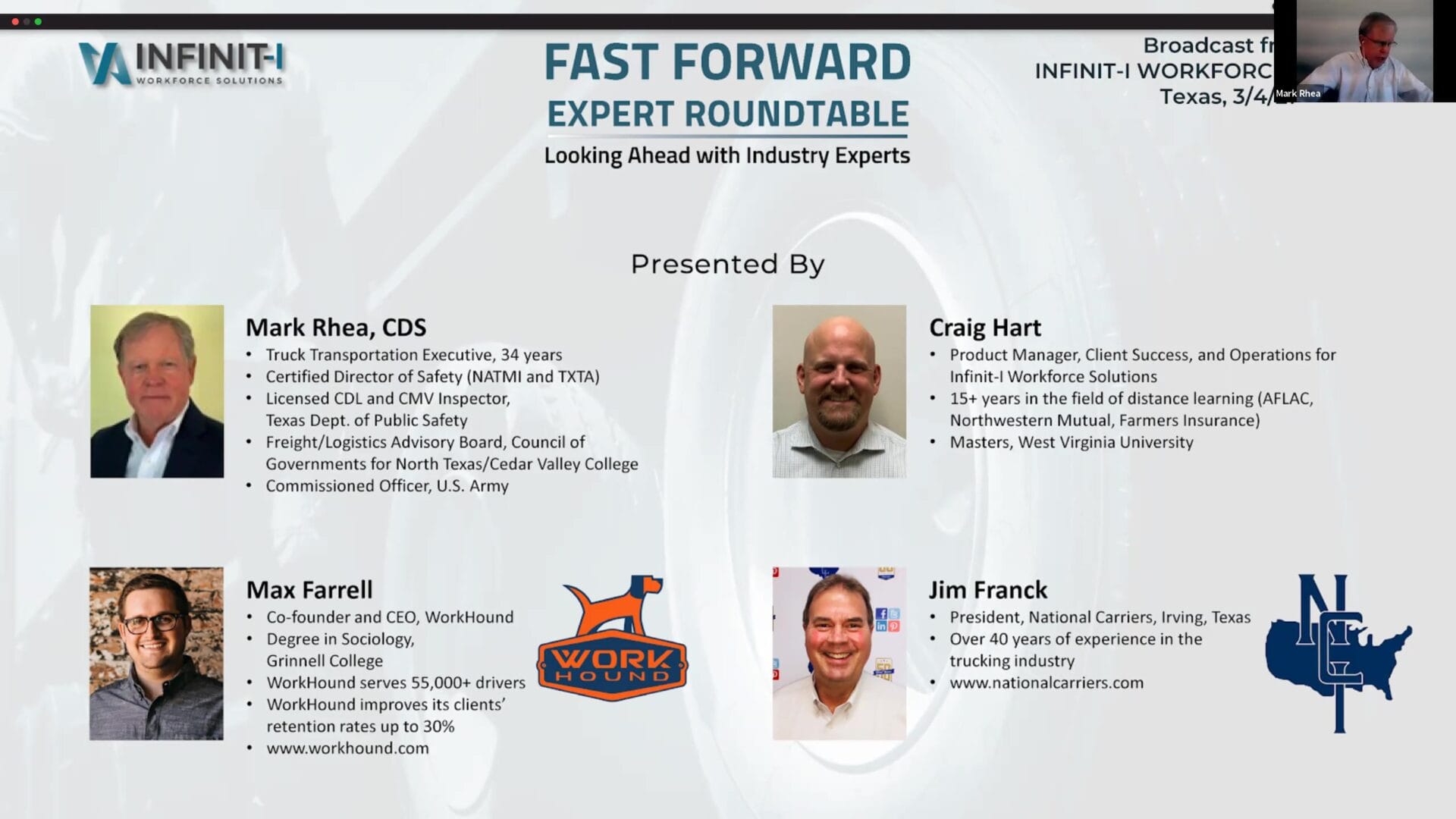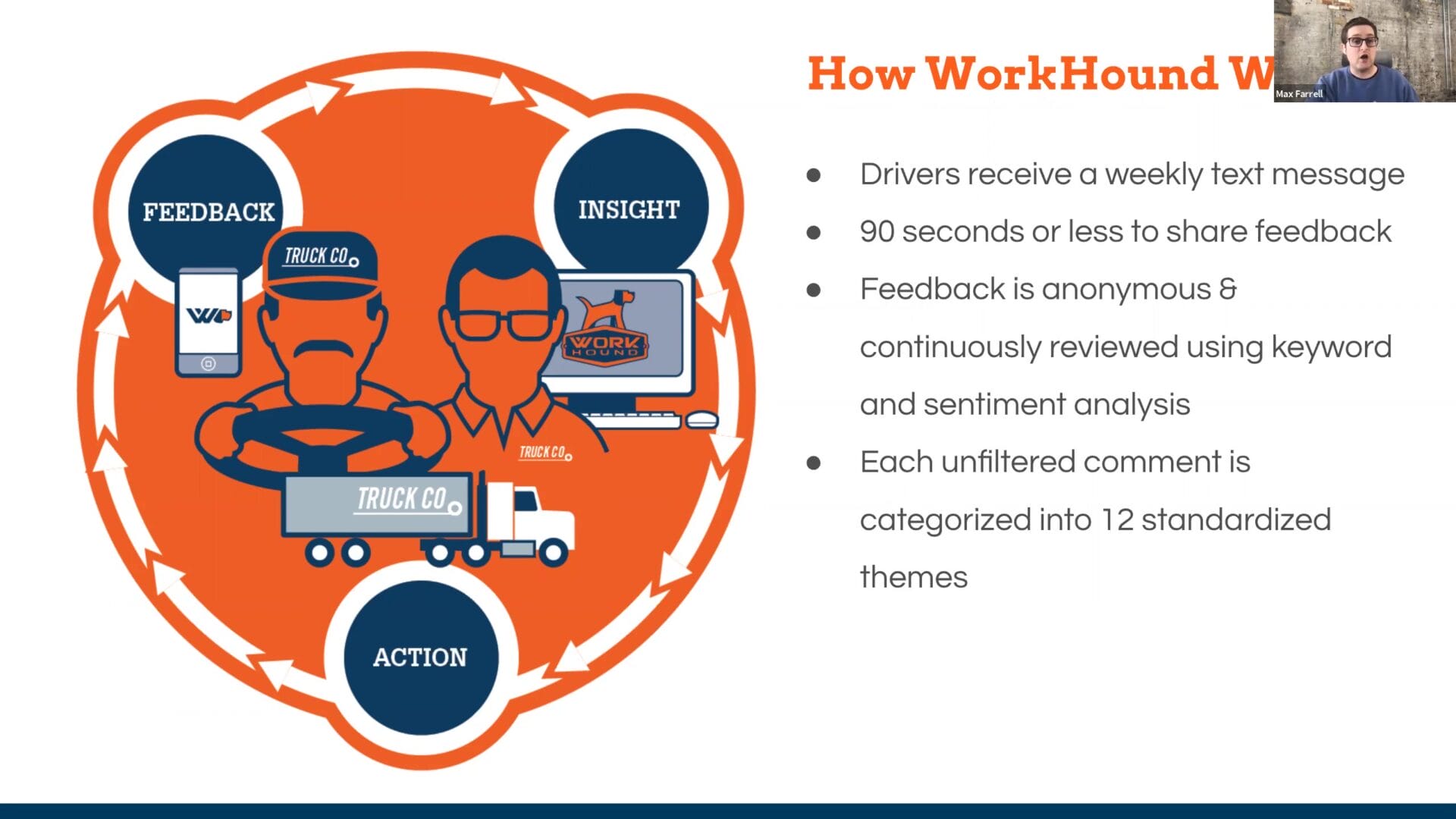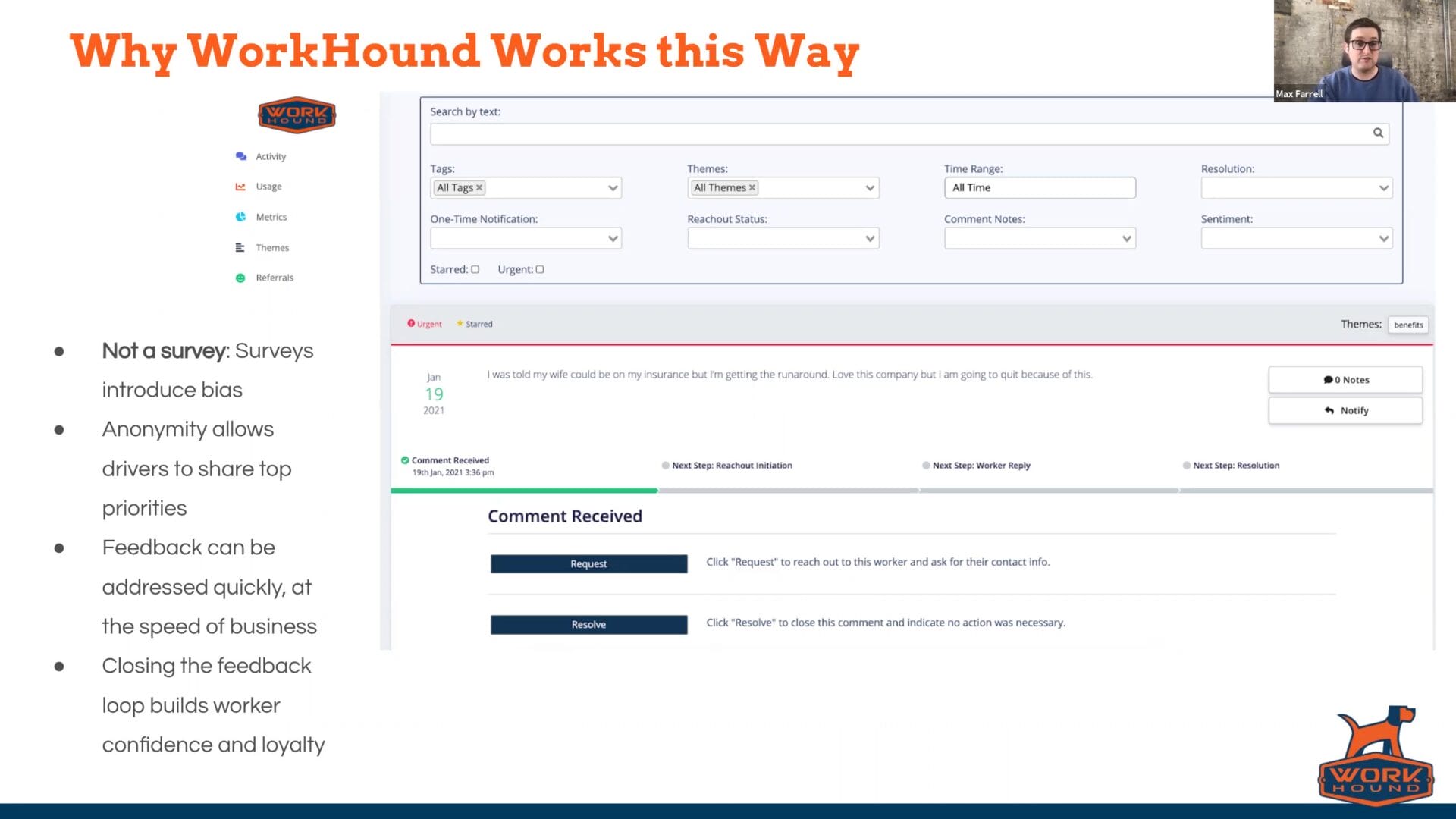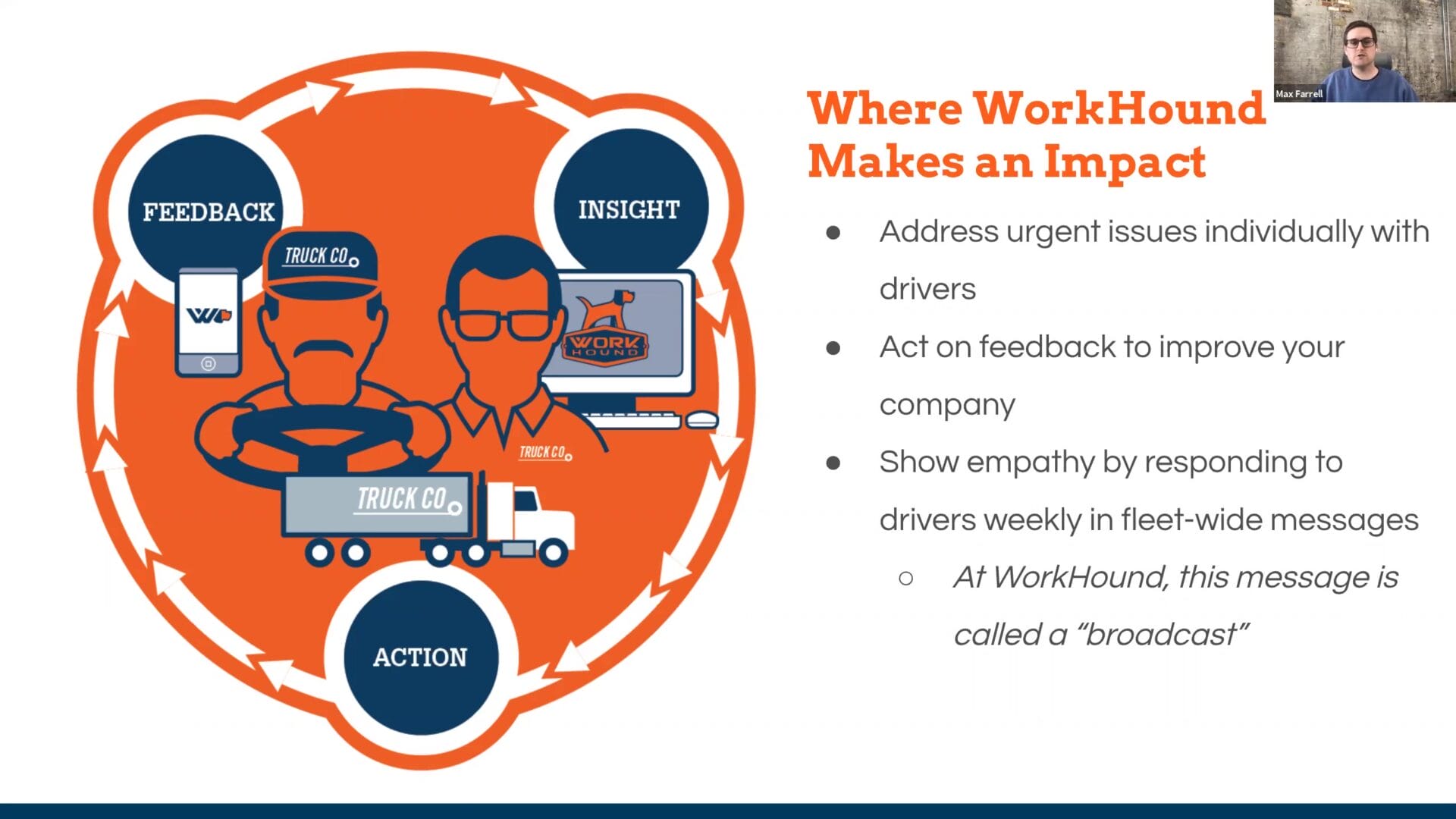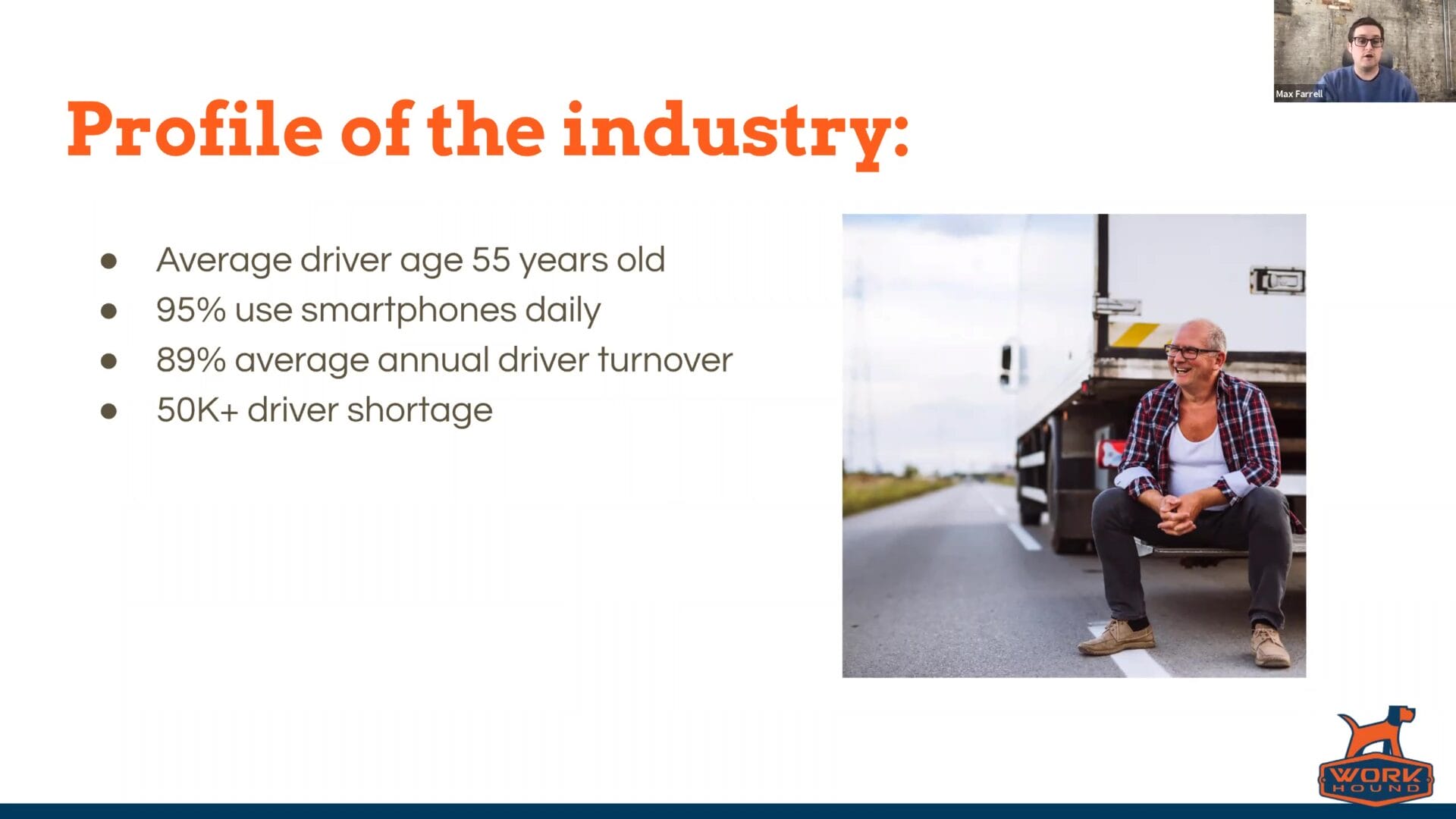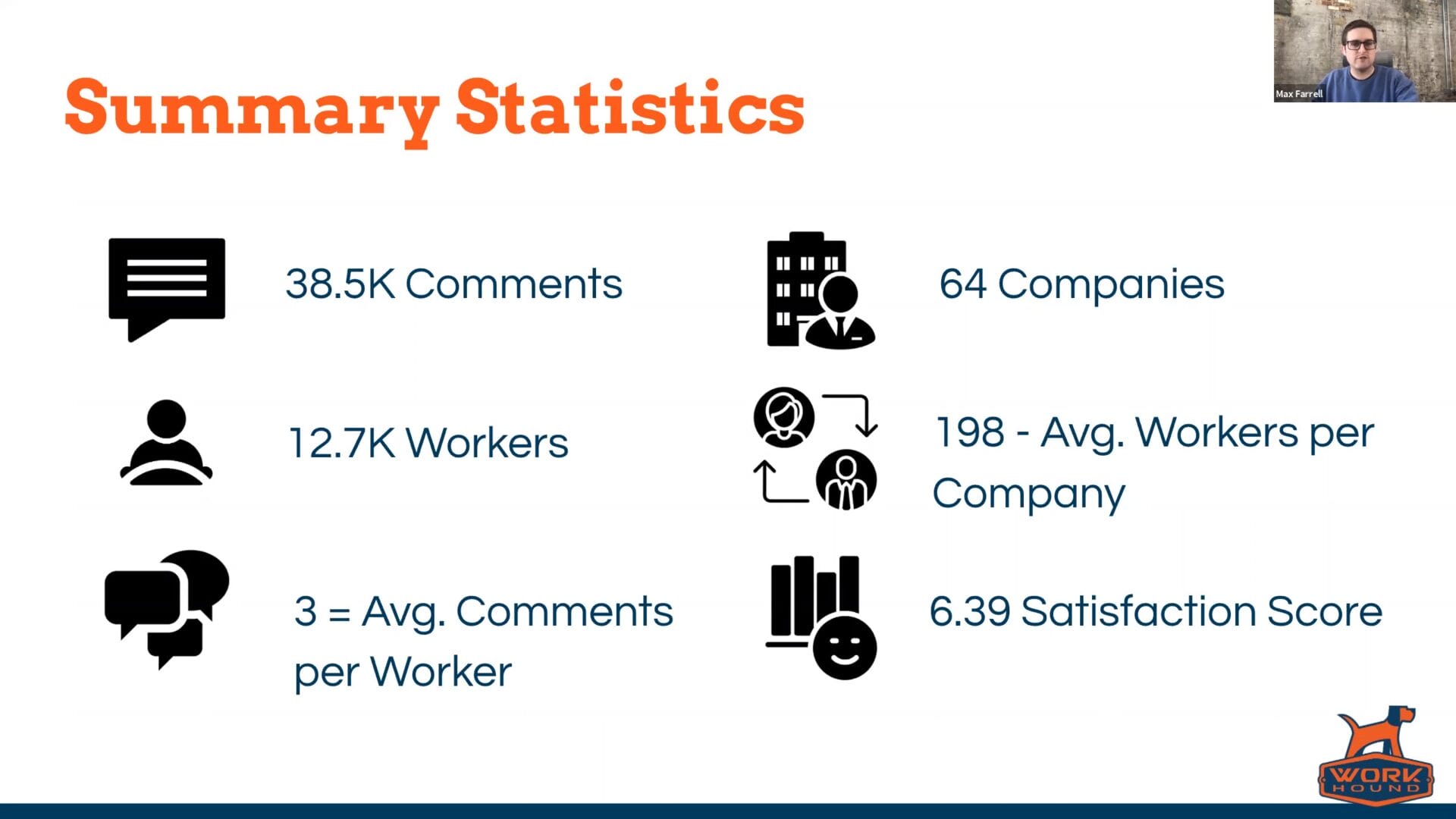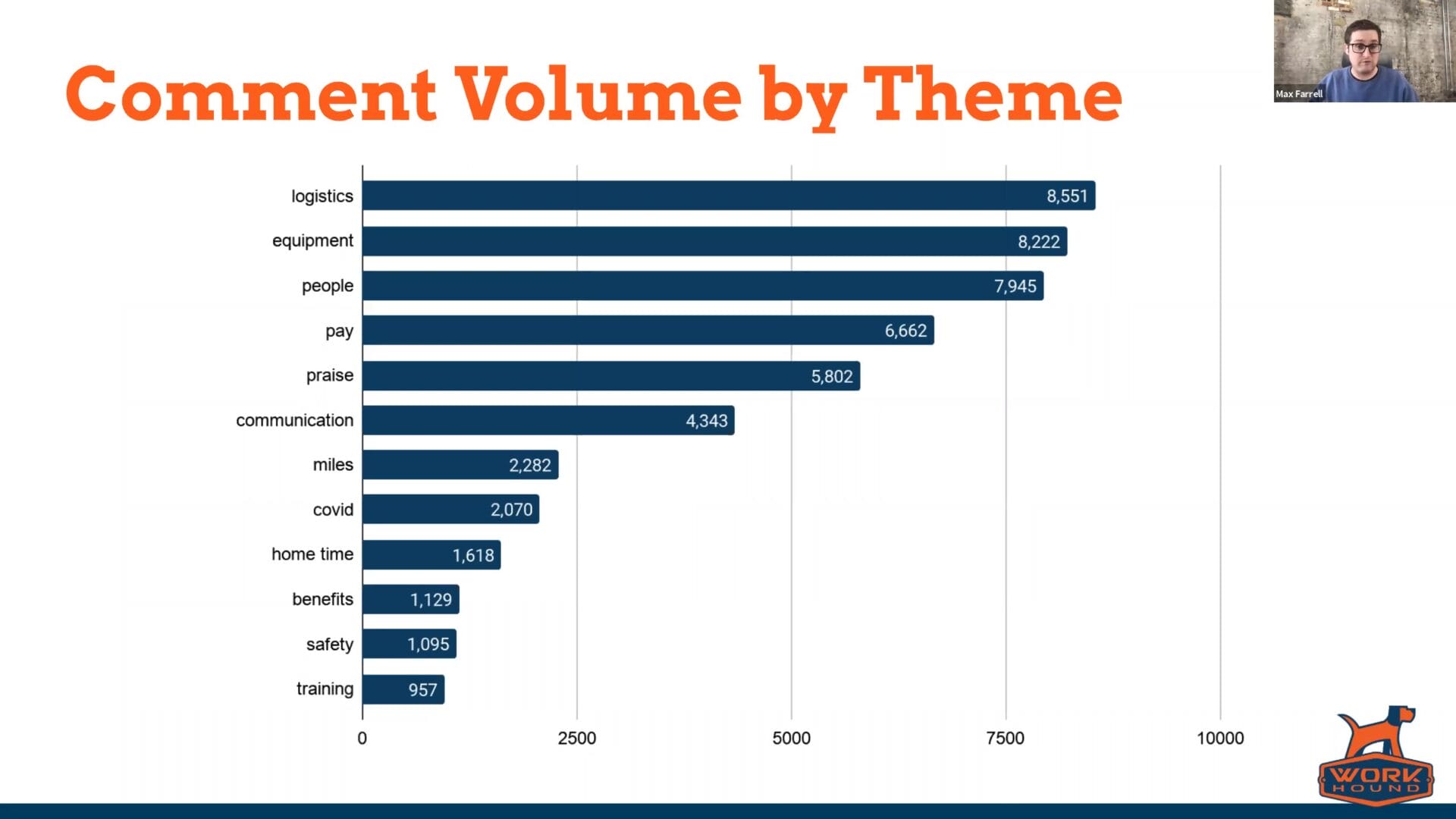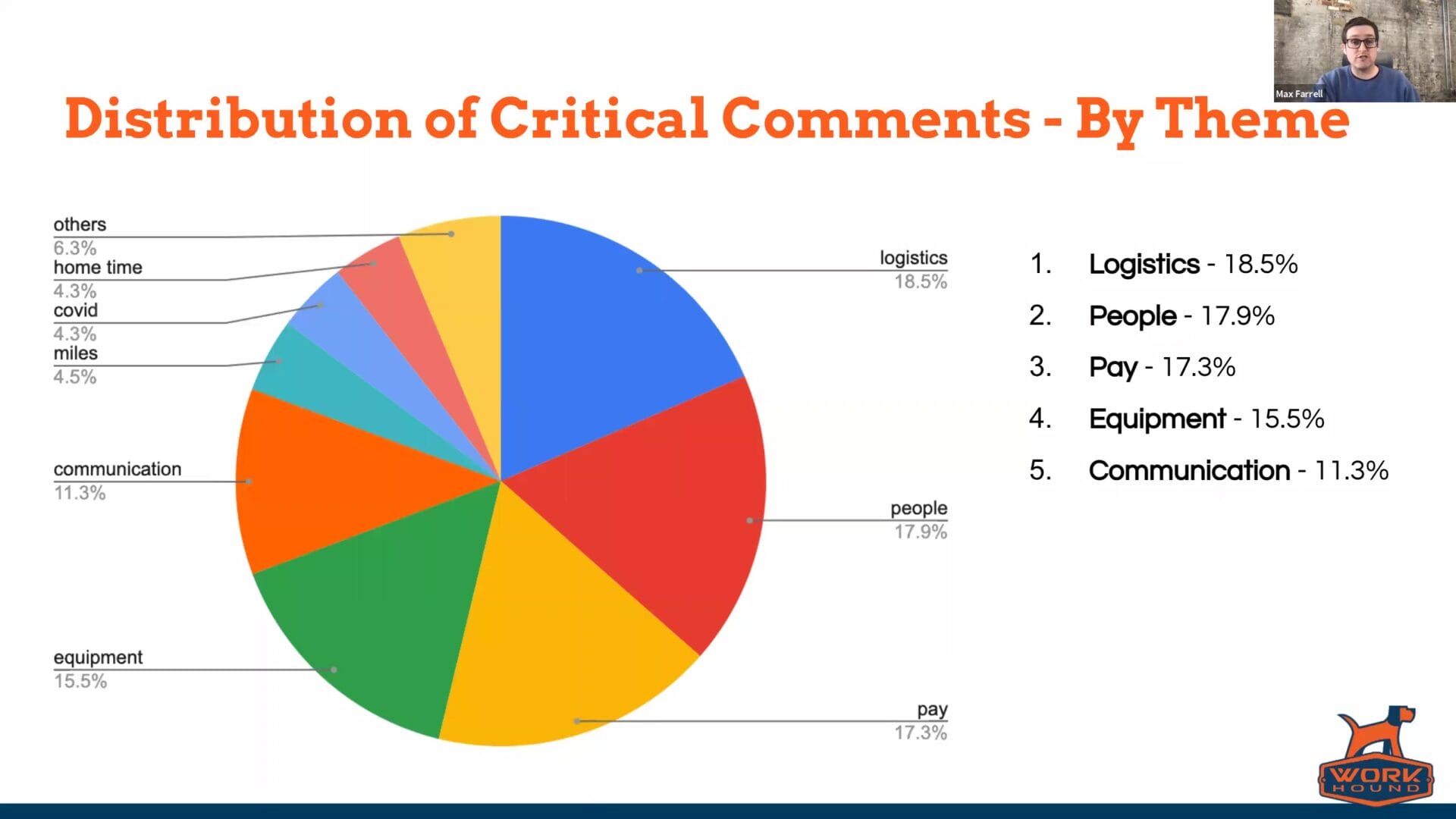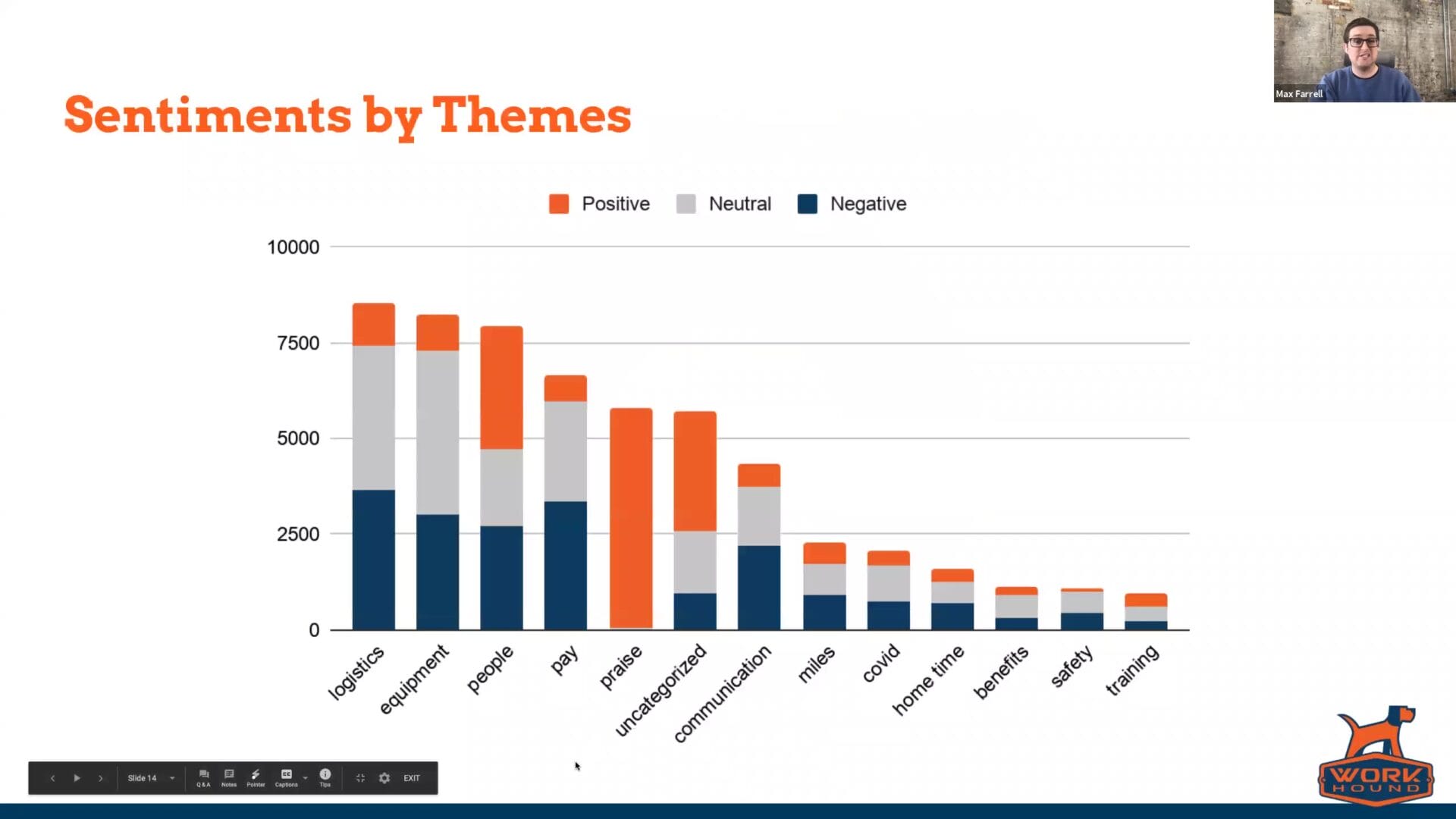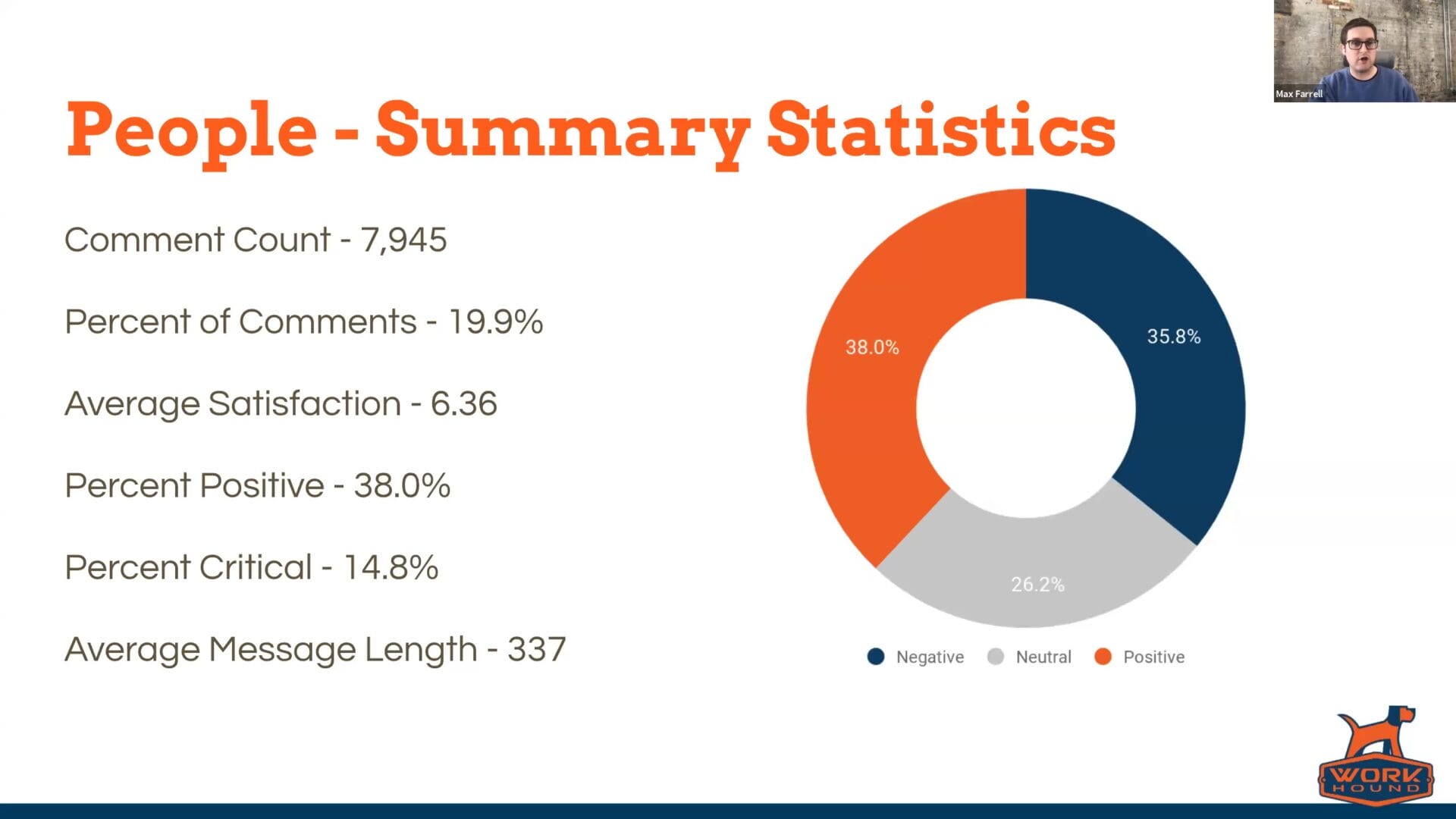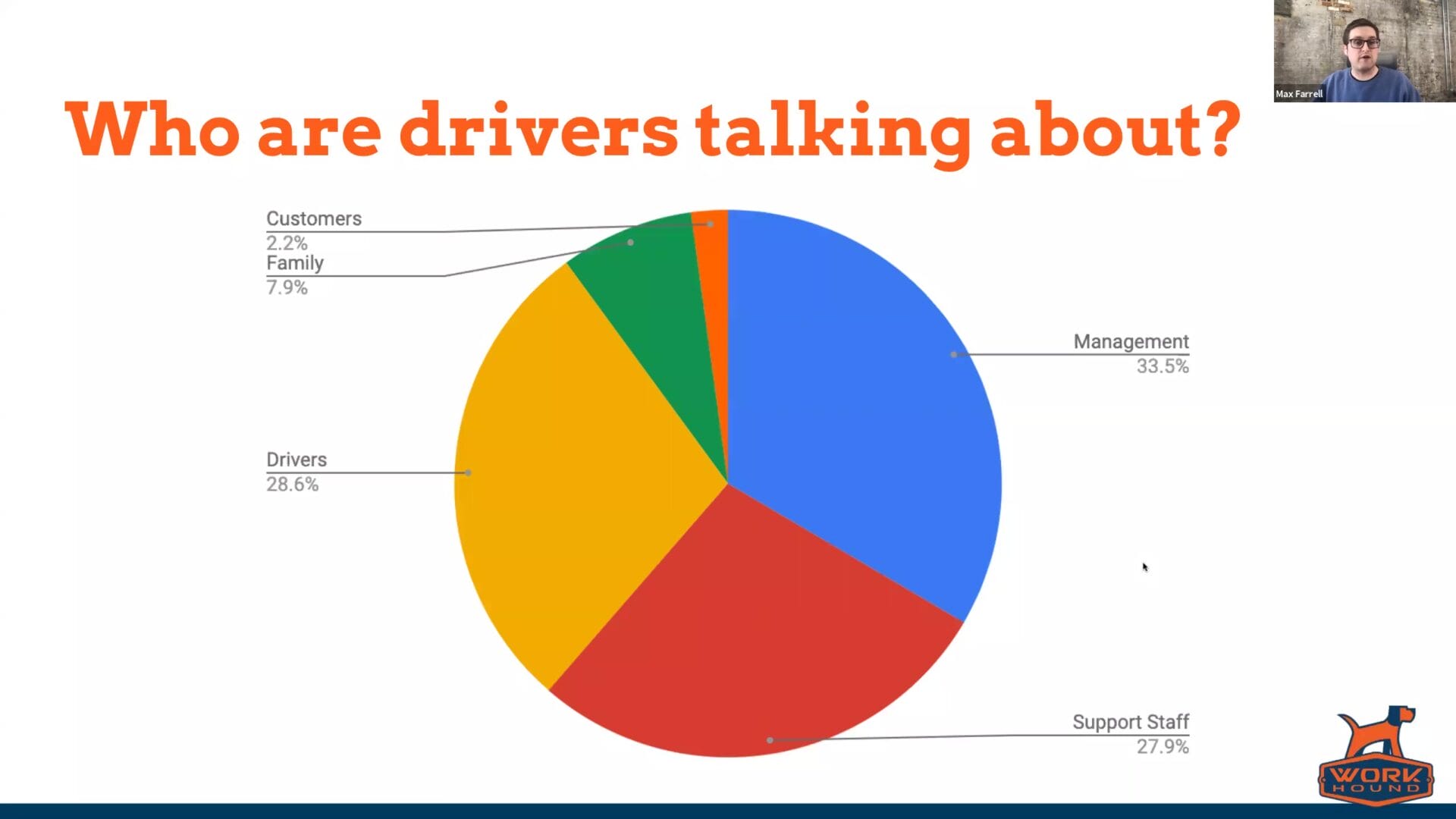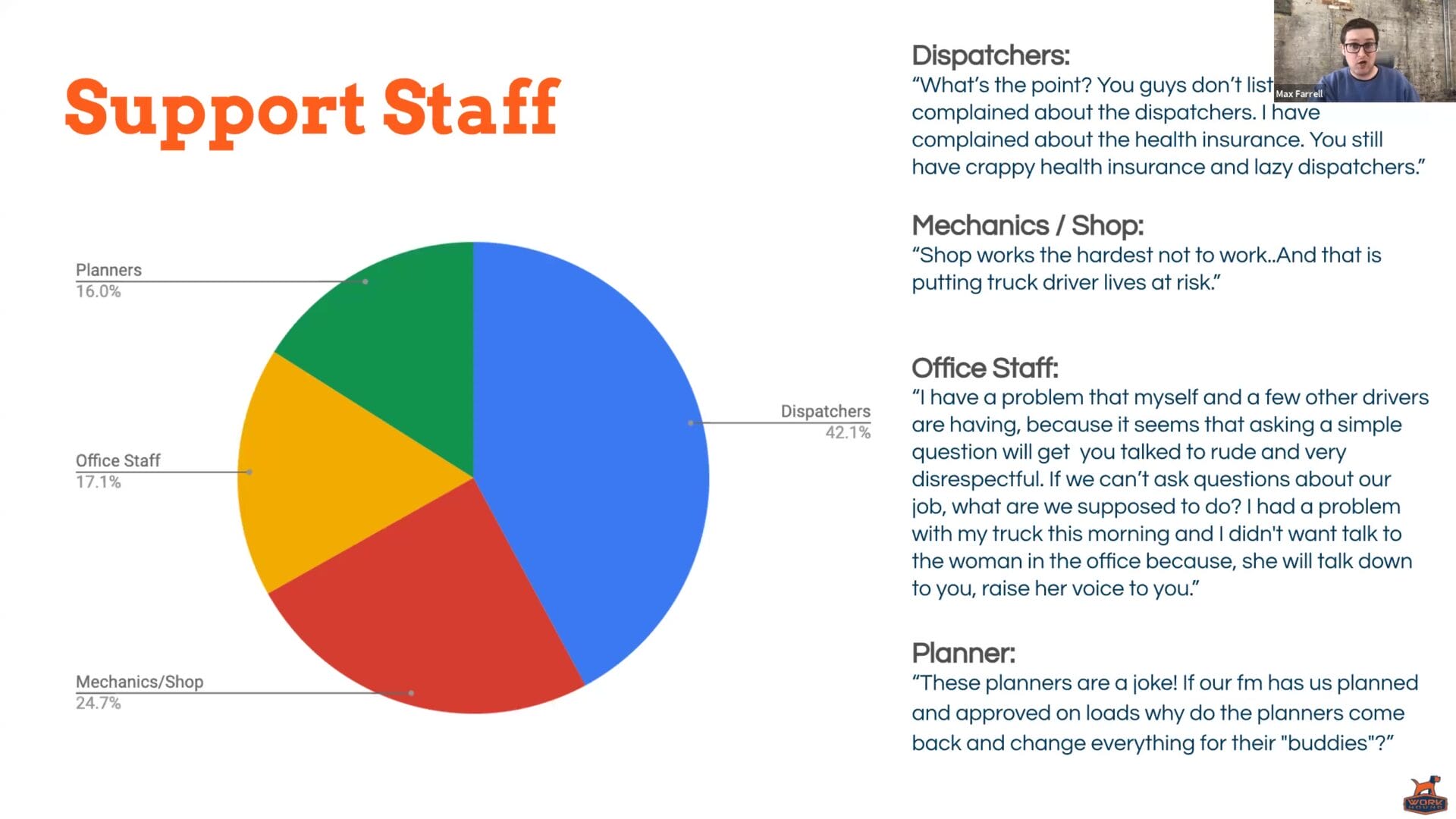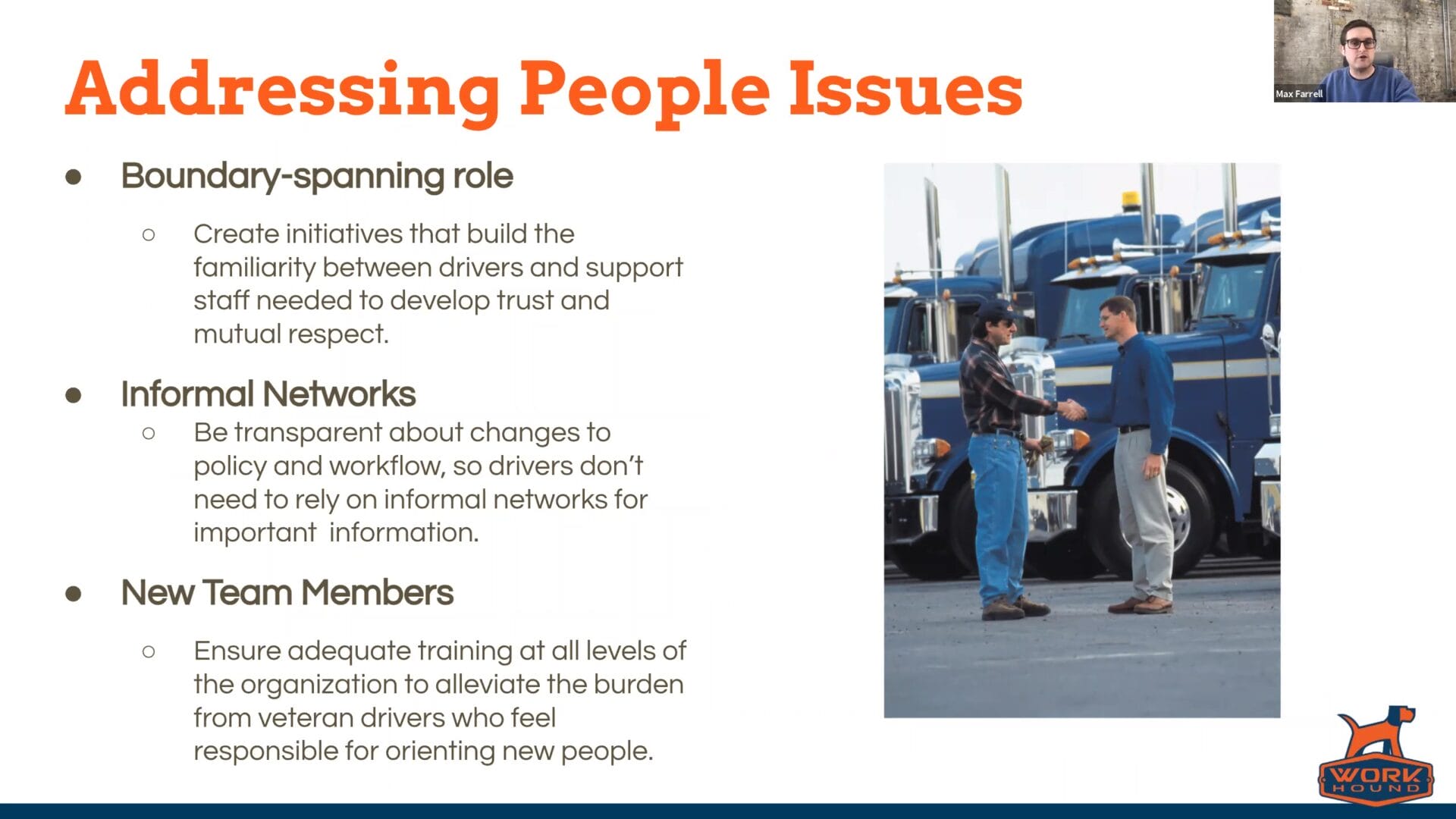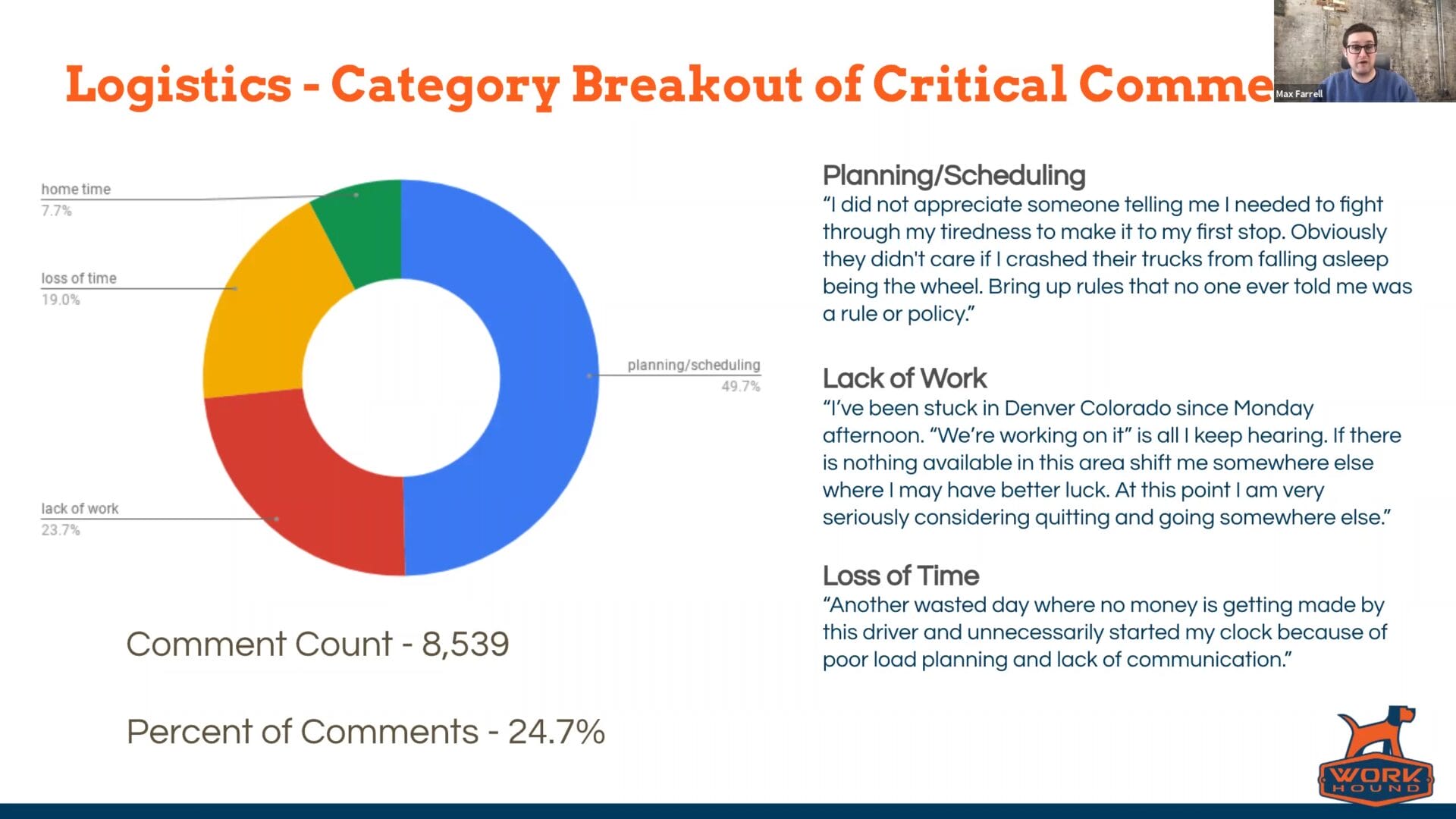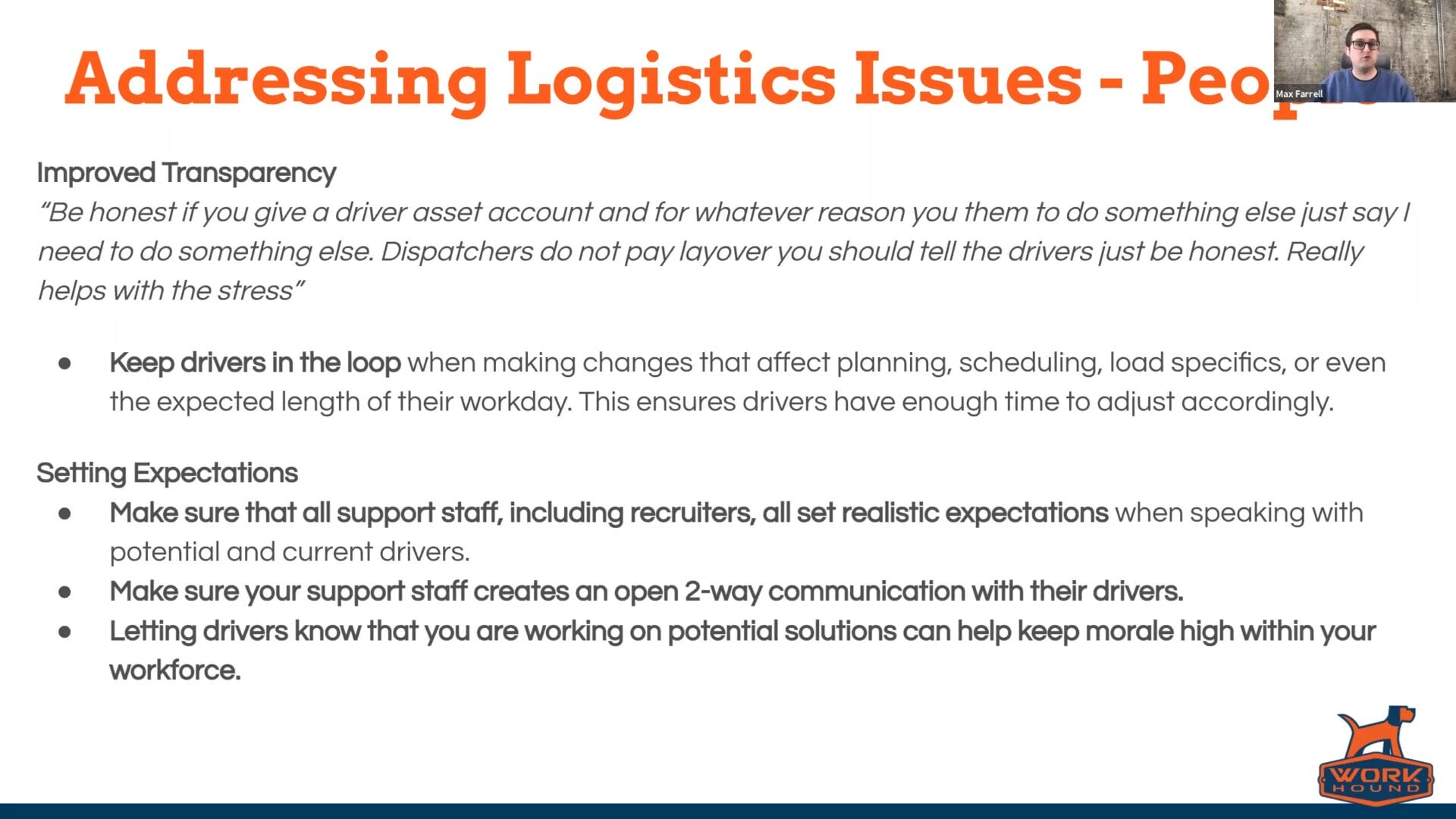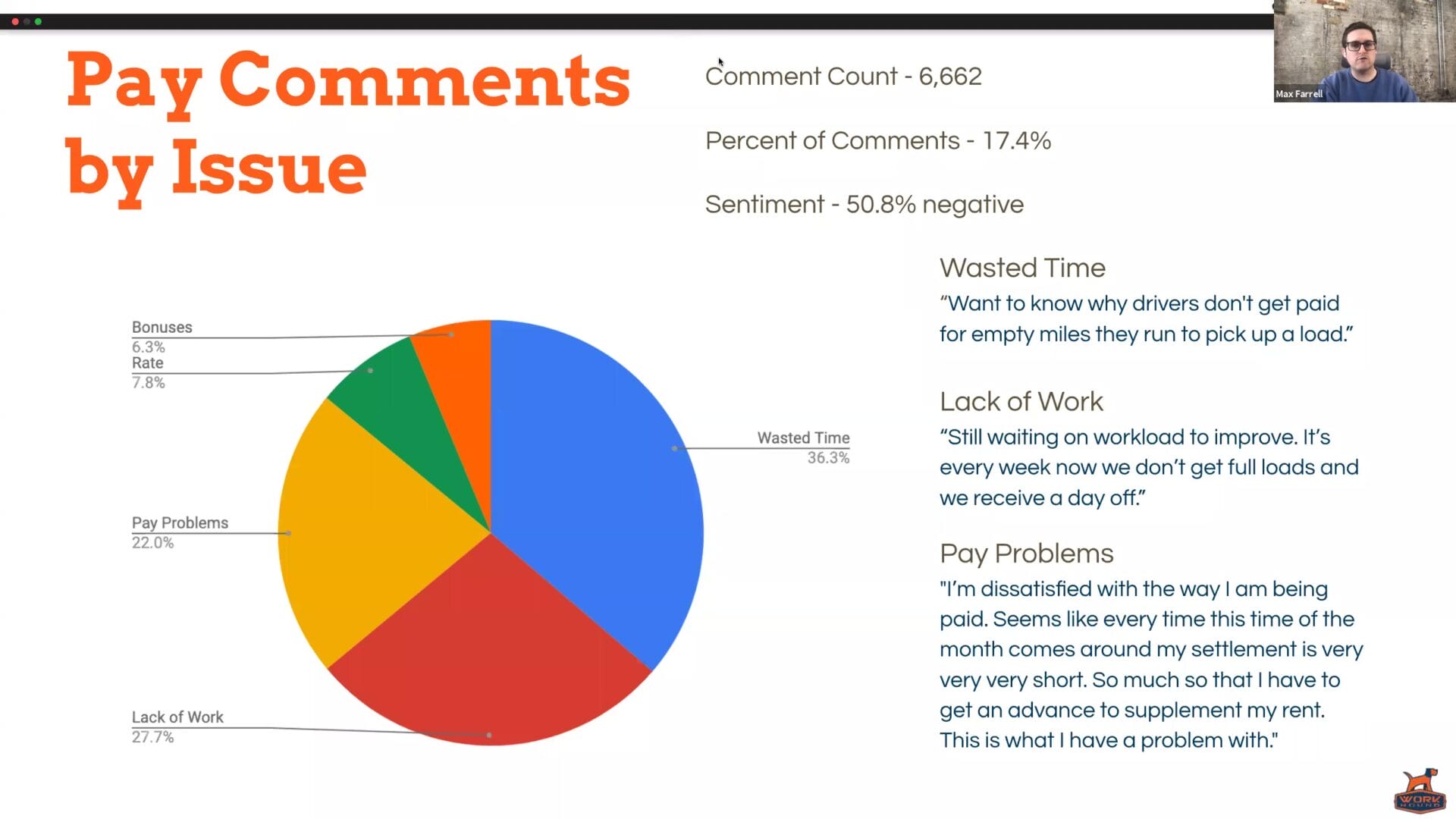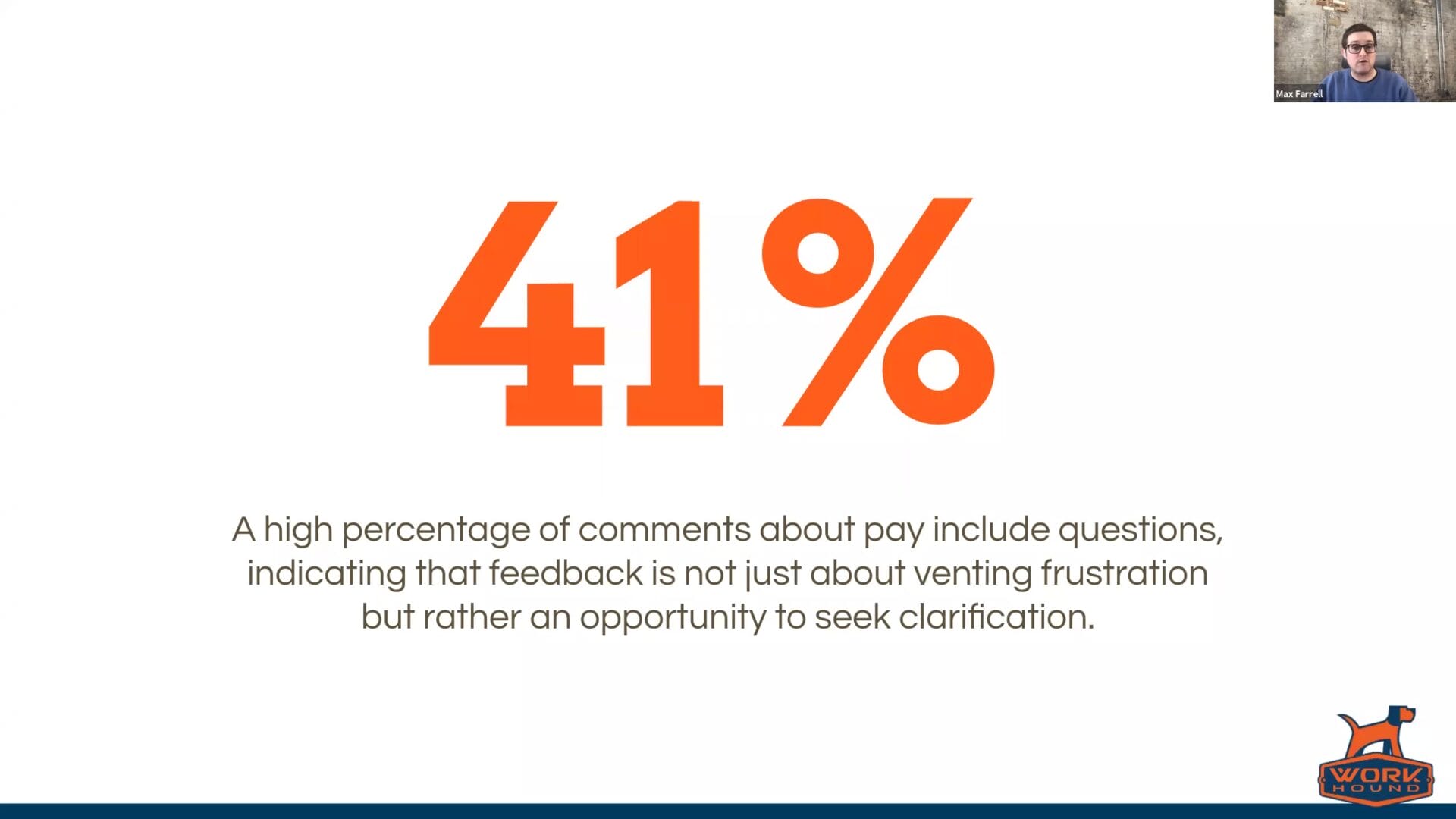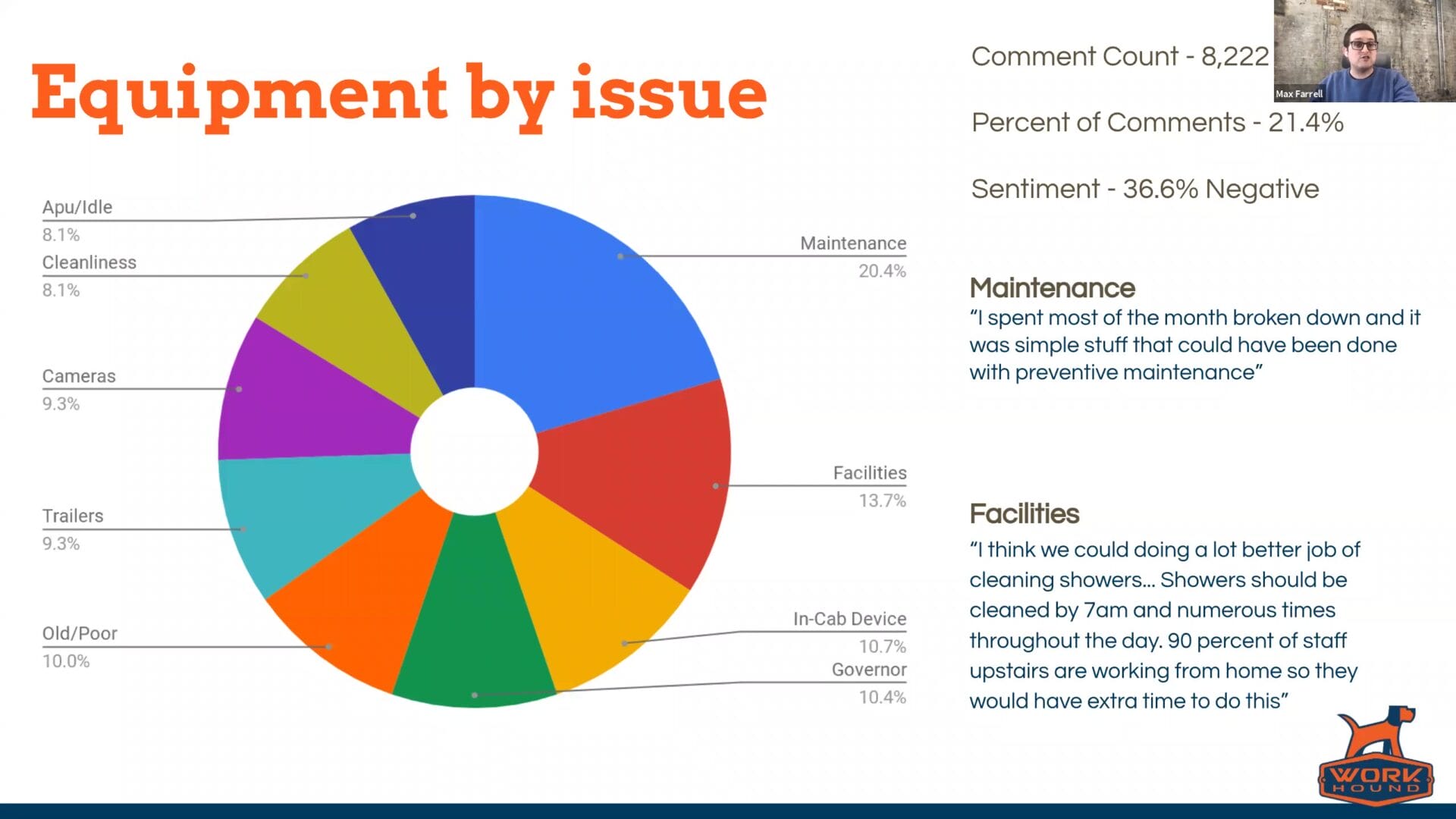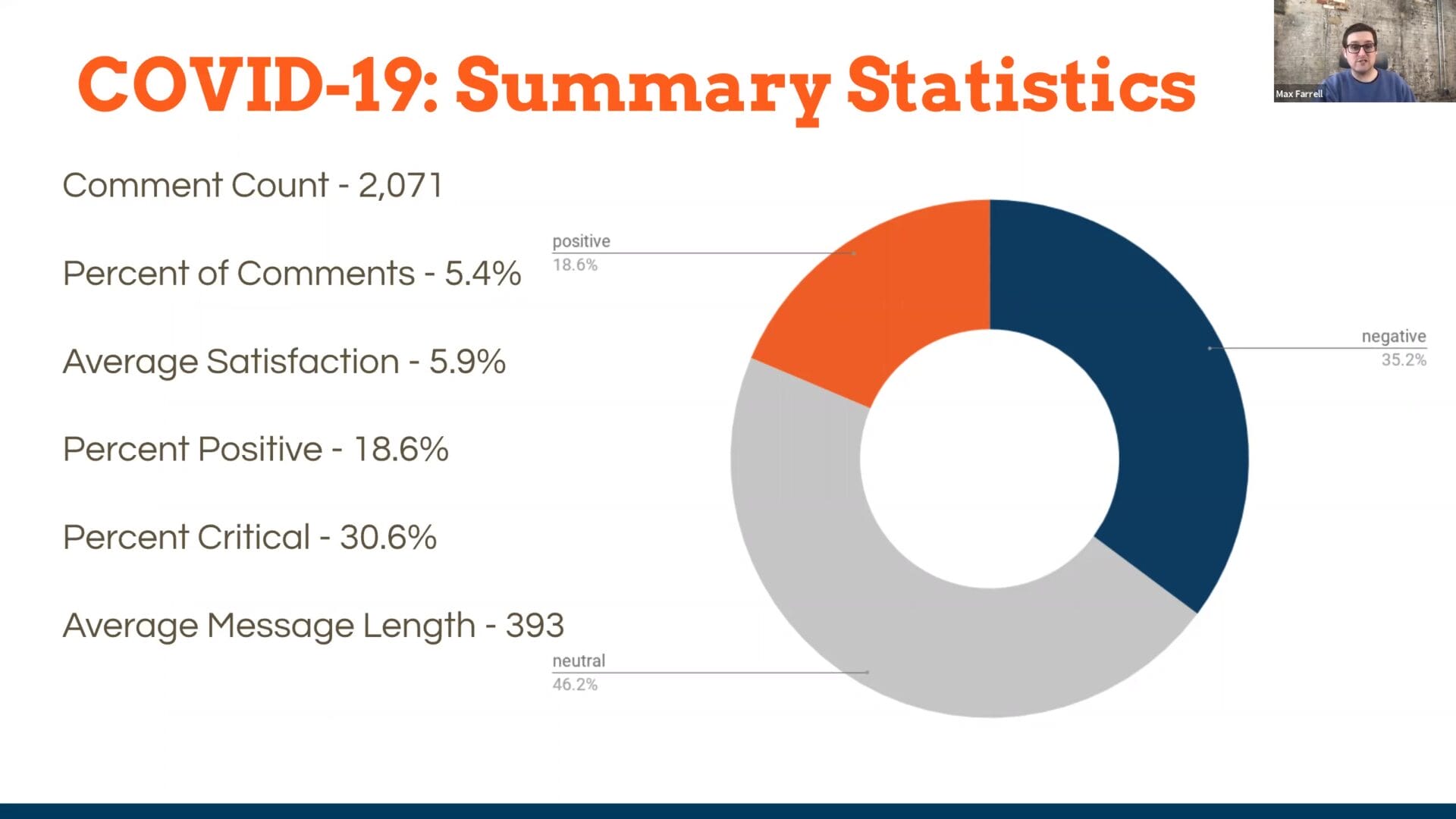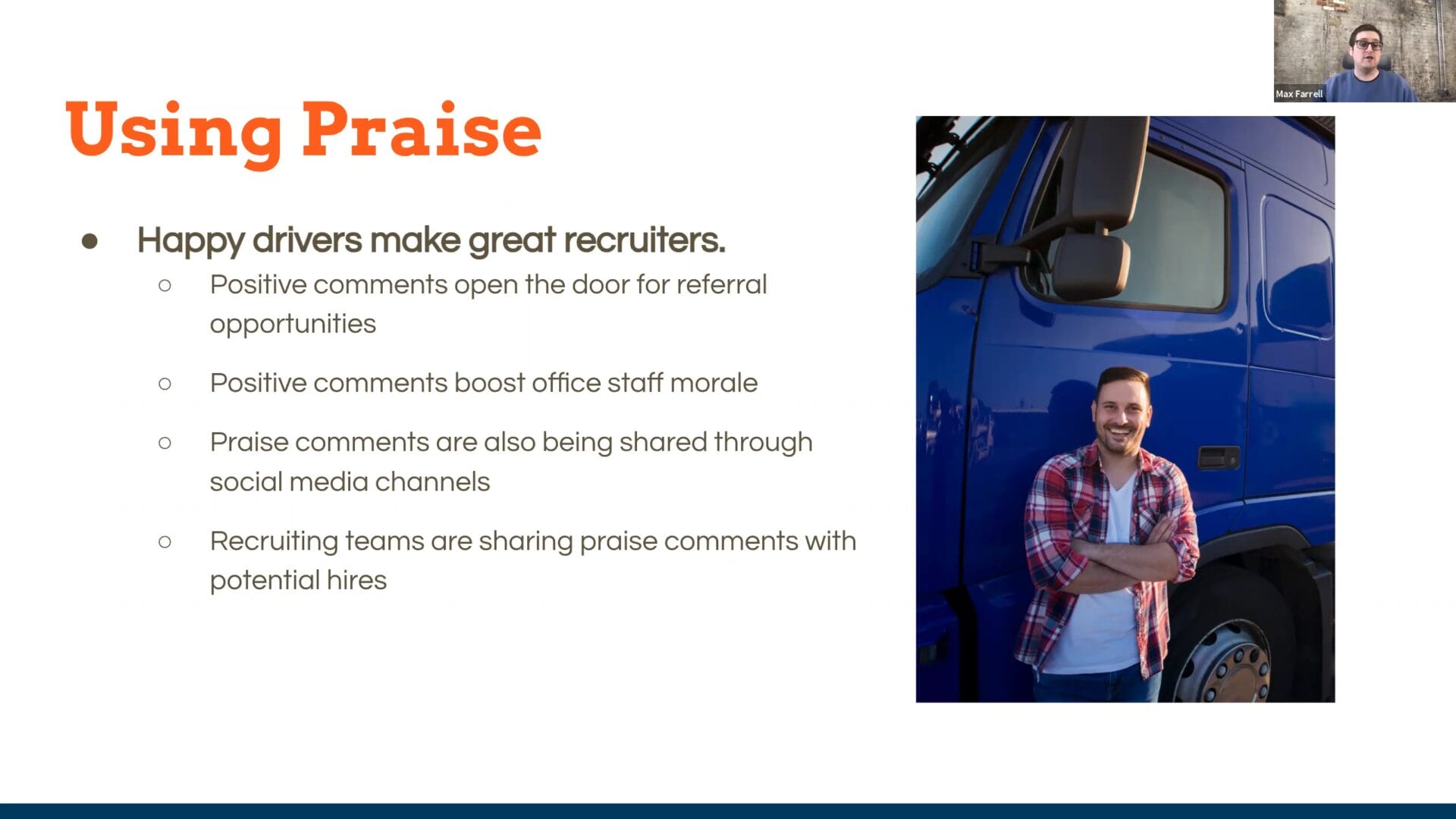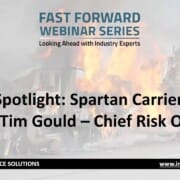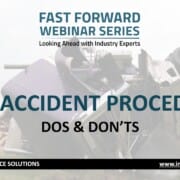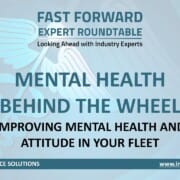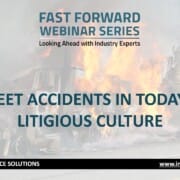Transcription
4
00:00:23.340 –> 00:00:35.670
Mark Rhea: Welcome everyone, my name is Mark Rhea and we’ve got a fantastic workshop webinar this morning on everybody’s favorite subject driver shortage today’s March 4, 2021.
5
00:00:36.150 –> 00:00:54.540
Mark Rhea: Today we’re going to be talking about feedback from your drivers, how to get that feedback what to do with that feedback when you get it from a company, Mr. Max Farrell the founder of work.
6
00:00:54.990 –> 00:01:01.290
Craig Hart: A marketing I’m gonna get you to hold for a moment and does not look like the attendees were opened up, yet we haven’t had anyone joined yet.
7
00:01:01.650 –> 00:01:02.940
Mark Rhea: Katie’s on mute.
8
00:01:04.350 –> 00:01:05.370
Mark Rhea: Katie Katie Katie.
9
00:01:05.700 –> 00:01:08.670
Katie Love: I had started webinar has begun.
10
00:01:10.650 –> 00:01:11.130
Craig Hart: Okay.
11
00:01:11.400 –> 00:01:25.500
Mark Rhea: Okay, here we go Max will be joining us with MAC with Work Hound joining him, Mr. Jim Frank, President of the Elite Fleet National Carriers now located in Dallas, Texas in his usage of that.
12
00:01:27.390 –> 00:01:38.190
Mark Rhea: Of this information, as well as Mr. Craig Hart our customer development executive at Infinit-I Workforce Solutions welcome everybody again driver shortage.
13
00:01:38.220 –> 00:01:39.720
Mark Rhea: driver fleet that.
14
00:01:40.620 –> 00:01:50.700
Mark Rhea: will be our topic for today, and here we are it’s March, the 4th driver shortage is real rates are up.
15
00:01:51.900 –> 00:01:53.850
Mark Rhea: frayed activity is up.
16
00:01:55.260 –> 00:02:03.360
Mark Rhea: equipment sitting idle so the missing component is obviously the drivers and everybody is struggling with that issue and we will.
17
00:02:03.960 –> 00:02:15.120
Mark Rhea: present to everyone today a very specific program that can help identify the issues your drivers are having to prevent them from entering that.
18
00:02:15.600 –> 00:02:36.360
Mark Rhea: retention turnover cycle, so if everybody would please open up your chat feature and give us some feedback on what you are doing out in the field, or if you’re even having maybe some of you are not having the driver shortage issues, but please open up your chat feature on the bottom.
19
00:02:38.010 –> 00:02:39.210
Mark Rhea: And we’ll get started.
20
00:02:40.830 –> 00:02:52.560
Mark Rhea: So what’s our industry doing to address the driver shortage I’ve heard everything from increasing rate of pay, to sign on bonuses, more modern equipment,
21
00:02:55.980 –> 00:03:03.810
Mark Rhea: home frequency promises, dispatcher soft skill training on and on and on.
22
00:03:05.730 –> 00:03:24.240
Mark Rhea: A lot of entry level driving training programs so there’s a lot of different strategies to address this driver shortage, but today we want to talk with Max and Jim specifically about how you can get a neutral party to address this issue.
23
00:03:25.650 –> 00:03:28.920
Mark Rhea: and get the feedback from them so before we get.
24
00:03:28.950 –> 00:03:41.280
Mark Rhea: too deep into this I’ve introduced myself, Max, Jim, and Craig we’re having a few little delay us with the program hope hopefully everybody’s out there.
25
00:03:42.900 –> 00:03:48.480
Mark Rhea: Max before we get started, I know you’ve got a lot of information share a lot of 2020 data that you’ve recovered.
26
00:03:49.620 –> 00:03:57.930
Mark Rhea: From drivers matter of fact, I think you’ve gotten 38,500 driver feedback comments.
27
00:03:58.950 –> 00:04:09.120
Mark Rhea: In 2020 and we’re certainly looking forward to that, but before we get into that were there any surprises, and what did you see driver saying in 2020.
28
00:04:10.590 –> 00:04:12.900
Mark Rhea: different from prior years.
29
00:04:14.340 –> 00:04:32.490
Max Farrell: Well, first and foremost the the biggest difference was the fact that we been in the middle of a pandemic and COVID-19 was certainly something front and Center that was not mentioned at all in 2019 that was definitely something that we saw.
30
00:04:33.570 –> 00:04:35.580
Max Farrell: mentioned significantly in 2020.
31
00:04:36.630 –> 00:04:45.780
Max Farrell: And you know as we look out independent of that if we look at 2019 to 2020 what we saw is that there was a lot of positive feedback that we weren’t.
32
00:04:46.410 –> 00:05:01.920
Max Farrell: Isolating and recognizing and so in 2019 we saw that about a third of our data was positive feedback and we created a praise theme to help companies isolate that that information, and you know something else that we saw was that.
33
00:05:03.210 –> 00:05:16.560
Max Farrell: The issue of healthy communication touched almost every problem that drivers face so something that will get into here shortly, is that with pay often it’s a communication issue, more so than than a an exact amount issue.
34
00:05:17.730 –> 00:05:28.380
Max Farrell: And although the the comment volumes by themes were really consistent year to year we did see more critical comments about people surface in 2020 compared to.
35
00:05:29.670 –> 00:05:36.660
Max Farrell: Whereas in 2019 there were more there’s a higher volume of comments around external factors and technology, like.
36
00:05:36.660 –> 00:05:38.400
Max Farrell: New ElDs, cameras,
37
00:05:38.610 –> 00:05:44.370
Max Farrell: Government regulations, and that sort of thing so those are some of the the immediate takeaways we saw.
38
00:05:44.940 –> 00:05:51.420
Mark Rhea: So, so the praise theme you meet you tell us a little bit about that is that praising.
39
00:05:53.340 –> 00:05:56.220
Mark Rhea: tell us a little bit about the praise theme and how that works.
40
00:05:56.700 –> 00:06:05.280
Max Farrell: yeah so with with praise it’s it’s that, as you can imagine kind of like if somebody leaves a review on yelp or Google.
41
00:06:05.850 –> 00:06:14.220
Max Farrell: Often it’s either really good or bad and usually if somebody’s frustrated they’re going to leave a longer comment and in our data we saw that.
42
00:06:14.490 –> 00:06:21.420
Max Farrell: A negative comment is going to be two to three times longer than your average comment, whereas a positive comment is going to be about half as long.
43
00:06:21.750 –> 00:06:28.860
Max Farrell: As people are just short and sweet about the things that they have to say, and it doesn’t neatly fall into a particular category, they may just say something like.
44
00:06:29.160 –> 00:06:36.750
Max Farrell: I’m having a great week or I love working here that doesn’t necessarily fall into equipment or people or comments about operations.
45
00:06:37.110 –> 00:06:47.730
Max Farrell: So being able to isolate those those small things and share hey we’re getting a lot of attaboys they’re just short sweet and to the point, but we still need to pause reflect and recognize them and that’s what we did there.
46
00:06:48.480 –> 00:06:54.360
Mark Rhea: Fantastic Okay, well, I know you’ve got a lot of information, I know you got Mr. Jim Frank joining you.
47
00:06:56.190 –> 00:07:10.170
Mark Rhea: Before we turn over the formal presentation, if you would please open up your chat tell us what you’re doing out in the field, what your observations are what your experience has been using whether it’s a sign on bonus whether its.
48
00:07:11.190 –> 00:07:16.680
Mark Rhea: Entry level driver training program or if you’re not having any driver shortage issues at all.
49
00:07:17.940 –> 00:07:32.730
Mark Rhea: Let us know if you could just add that to the chat feature and without any further ado I’m going to turn the presentation over to you Max so tell us what everybody what the drivers are saying in 2020.
50
00:07:34.410 –> 00:07:35.340
Max Farrell: happy to do it.
51
00:07:36.510 –> 00:07:47.700
Max Farrell: So first off I do want to thank everyone for for attending and as Mark shared we’re going to dig into driver feedback from 2020, which is the year, unlike any other.
52
00:07:48.270 –> 00:07:59.970
Max Farrell: And what we did is we took feedback across our entire population of drivers who use Work Hounds, so that we can equip the industry to make change happen and ultimately retain more drivers.
53
00:08:00.780 –> 00:08:05.760
Max Farrell: Before we get started, I do want to thank a few people from the Work Hound team for making this presentation possible.
54
00:08:06.360 –> 00:08:15.390
Max Farrell: do want to thank Mark Ehlers, Corey Banks, Paul Castronova and Katie Love for putting this this report in this data together, so thank you all enough.
55
00:08:15.900 –> 00:08:27.810
Max Farrell: or I can’t Thank you well enough so we’ll cover a few different topics today so first off we’ll discuss how Work Hound feedback is gathered.
56
00:08:28.410 –> 00:08:32.550
Max Farrell: will also discuss some of the summary statistics we saw across different themes.
57
00:08:33.030 –> 00:08:47.580
Max Farrell: will really dig into the top three feedback themes and also bring in Jim from from National Carriers talk about how carriers are using this data to make change happen and finally we’ll open it up to Q&A at the end of this.
58
00:08:48.720 –> 00:08:51.030
Max Farrell: So at at Work Hound.
59
00:08:52.380 –> 00:09:01.380
Max Farrell: We gather anonymous real time feedback from thousands of frontline workers across the country and in trucking we received driver feedback from drivers.
60
00:09:01.860 –> 00:09:06.570
Max Farrell: Via regular text message asking drivers to share how work is going and why they feel that way.
61
00:09:07.170 –> 00:09:14.970
Max Farrell: And our focus and helping trucking companies in the drivers is to create a real time feedback loop, as you see in this image so weekly.
62
00:09:15.270 –> 00:09:21.870
Max Farrell: we’re asking drivers to share the good the bad and the ugly through a text message link that is live 24-7.
63
00:09:22.320 –> 00:09:37.170
Max Farrell: They share exactly what’s on their mind and 90 seconds or less feedback is continuously reviewed using keywords and sentiment analysis and we take every comments that’s unfiltered and categorize it into standardized themes and so there’s a.
64
00:09:37.410 –> 00:09:37.890
Mark Rhea: reason.
65
00:09:38.040 –> 00:09:45.000
Mark Rhea: MAX yes, I found as a neutral party that the drivers are more open with their observations and comments.
66
00:09:46.140 –> 00:09:54.630
Max Farrell: Absolutely it’s the the ugly truth of this industry is that there is a fear of retaliation, and so being able to.
67
00:09:55.050 –> 00:10:04.800
Max Farrell: Give a platform to share anonymous feedback but do it whenever they’re feeling a certain way is really powerful because in this business a guy can be happy, on Tuesday.
68
00:10:05.040 –> 00:10:12.390
Max Farrell: fed up on Wednesday and quit by the end of the week it’s that volatile so being proactive instead of reactive is the right way to move forward.
69
00:10:16.320 –> 00:10:28.560
Max Farrell: But as far as you know why we we do gather feedback this way you know first off we’re not a traditional survey, we ask open ended questions so drivers can introduce their honest concerns.
70
00:10:29.160 –> 00:10:34.590
Max Farrell: so that they can share what’s what’s on their mind and carriers can get to the point of addressing those sorts of things.
71
00:10:35.070 –> 00:10:42.870
Max Farrell: And we want to make sure that it’s addressed in a quick fashion, so you can really can get to the meat of issues at the speed of business.
72
00:10:43.170 –> 00:10:53.070
Max Farrell: And then, finally, we want to close the feedback loop because getting feedback is good, taking action is better, but telling people what we did builds worker confidence and loyalty.
73
00:10:55.020 –> 00:11:00.180
Max Farrell: So understanding how we close the feedback loop is important for the data we share today.
74
00:11:01.020 –> 00:11:09.030
Max Farrell: So, once we get feedback from drivers and address them, we know that we’re able to continue to evolve how the company operates.
75
00:11:09.270 –> 00:11:21.030
Max Farrell: And so we see companies address this feedback, in a few different ways, one would be addressing urgent issues individually with their drivers and we’re able to actually measure how company, how many people they retain from that.
76
00:11:21.450 –> 00:11:31.920
Max Farrell: We also see companies act on feedback to improve the company so using the the data is operational intelligence to make either small or significant strategic changes.
77
00:11:32.370 –> 00:11:45.570
Max Farrell: And then, finally, we see companies respond back to the entire fleet in a fleet wide message we call a broadcast to share hey here’s the actions we’re taking here’s the initiatives we’re looking into and here’s some of the miscommunications.
78
00:11:46.680 –> 00:11:53.490
Max Farrell: And as we think about the the demographics, of the industry, we do see that the average age of drivers is about 55.
79
00:11:54.450 –> 00:12:09.330
Max Farrell: It varies across companies 95% of drivers are using smartphones daily across the industry, the average annual driver turnovers around 90% and there is a driver shortage where we’re seeing over 50,000.
80
00:12:09.900 –> 00:12:22.320
Max Farrell: driver shortage across the country, and so you combine all these factors together and makes a really strong incentive for companies to want to fill up the leaky bucket and patch it up as best as possible.
81
00:12:24.360 –> 00:12:29.610
Mark Rhea: So in 2020 demand for services is up there’s plenty afraid out there all right now.
82
00:12:30.390 –> 00:12:43.860
Max Farrell: It definitely is I can’t tell you how many times, we talked to a company that you know if if we’ve got a driver if you’ve got a driver we’ve got a truck and we’ve got freight, I mean that’s that’s the reality across the industry right now.
83
00:12:45.690 –> 00:13:01.950
Max Farrell: As we looked at the the summary statistics across our data we had over 38,000 comments from from more than 13,000 drivers who left about three comments per person, on average, and so this is for for companies that.
84
00:13:02.790 –> 00:13:15.840
Max Farrell: usually have over 100 drivers, we have companies that have 100 all the way to several thousands and we saw the average satisfaction score on a scale of one to 10 was 6.39.
85
00:13:18.180 –> 00:13:30.540
Max Farrell: So is I do want to look at the comment volume by theme, because if you look in 2020 we noticed that logistics was the most common topic of feedback and and that sort of feedback really ties into.
86
00:13:31.620 –> 00:13:44.160
Max Farrell: To operational data and so today because logistics tends to appear, along with other themes will talk mostly about people, pay, equipment, praise, and the COVID thing because we’d have been navigating a pandemic.
87
00:13:45.030 –> 00:13:56.610
Max Farrell: Something that you’ll notice is that while communication is a theme didn’t make the top five, it also appears that many of the themes highlighting the importance of clear and concise communication with drivers is key.
88
00:13:58.380 –> 00:14:09.060
Max Farrell: When we look at the distribution of critical comments, we see that, despite being frequently commented on issues around equipment to not to be as urgent as other things like people and pay.
89
00:14:09.750 –> 00:14:18.120
Max Farrell: In 2020 driver feedback trends show that greater attention should be focused on people and pay and so we’ll be spending the extra time on those two sections today.
90
00:14:18.360 –> 00:14:25.260
Max Farrell: Rather than the other areas of the business, since those contain a higher density of retention opportunities so we’ll look at those shortly.
91
00:14:27.120 –> 00:14:28.710
Max Farrell: Despite the challenges.
92
00:14:29.010 –> 00:14:29.910
Mark Rhea: Excuse me Max
93
00:14:29.940 –> 00:14:31.950
Mark Rhea: When you mean the logistics.
94
00:14:31.950 –> 00:14:36.810
Mark Rhea: Are you talking operation dispatch information load exchange.
95
00:14:36.810 –> 00:14:41.130
Mark Rhea: Between the driver and the in the back office is that logistics.
96
00:14:41.490 –> 00:14:57.990
Max Farrell: That is a great question, yes, it is, is pretty much everything operations related, but it is the logistics of moving the freight so it’s those sorts of interactions you know challenges with shippers, it really is a broad category.
97
00:14:58.350 –> 00:15:01.290
Mark Rhea: load assignments and pre plans and things like that.
98
00:15:01.920 –> 00:15:03.150
Absolutely okay.
99
00:15:04.860 –> 00:15:13.680
Max Farrell: And so, then, is we we look at the the comments sentiment, you can see it’s broken out pretty evenly across negative neutral and positive.
100
00:15:14.190 –> 00:15:22.080
Max Farrell: But we did see more positive comments in 2020 then in 2019 which is kind of surprising given the turmoil that we faced last year.
101
00:15:22.620 –> 00:15:32.760
Max Farrell: And as you can see positive is orange neutral is gray and blue represents the the negative comments and I know trucking always has a bad habit of trying to fix what’s broken.
102
00:15:33.300 –> 00:15:39.150
Max Farrell: But there’s a sizable number of drivers that are celebrating what’s working well and it’s important that we recognize those things.
103
00:15:40.320 –> 00:15:50.640
Max Farrell: Now, when it comes to breaking up the sentiment by theme it’s not evenly distributed, as you can see praise, people and on categorized comments have a greater likelihood of being positive.
104
00:15:51.000 –> 00:15:57.360
Max Farrell: than the comments of the other themes and with that I do want to jump into the people theme now.
105
00:15:57.900 –> 00:16:04.440
Max Farrell: Which is the third most frequently mentioned theme representing about 20% of all the comments that we received.
106
00:16:05.190 –> 00:16:13.590
Max Farrell: So outside of the praise theme it’s the most likely theme, to have a positive sentiment with 38% of the comments being positive.
107
00:16:14.190 –> 00:16:18.360
Max Farrell: commenters with the people theme frequently will shout out others.
108
00:16:18.810 –> 00:16:25.050
Max Farrell: The companies that we work with are maximizing the impact of this positivity by distributing the shout outs through the.
109
00:16:25.380 –> 00:16:33.300
Max Farrell: There are other internal channels now when comments in the people theme or negative it’s likely due to interpersonal or departmental conflict.
110
00:16:34.170 –> 00:16:45.570
Max Farrell: And it brings up a point around drivers facing a boundary spanning role because drivers are uniquely suited to their role to have regular interactions with a wide variety of other roles.
111
00:16:46.440 –> 00:16:54.000
Max Farrell: You know where we’ve named multiple populations with unique drivers whom they’re often associated with whether that’s dispatchers shippers.
112
00:16:54.870 –> 00:17:06.660
Max Farrell: The the planners other people inside the company and so while most drivers sign on to do a job, so they can drive they’re not often trained to understand how to manage the needs of these various conflicting roles.
113
00:17:07.110 –> 00:17:16.080
Max Farrell: and researchers at the University of Arkansas suggest that trucking is stressful, not only because of the usual suspects of stress into induced by the job.
114
00:17:16.350 –> 00:17:24.330
Max Farrell: But because of the expectation of juggle the relationships in interactions often with conflicting organizational goals and expectations.
115
00:17:25.110 –> 00:17:38.010
Max Farrell: Because they must interact with various company employees and try to meet customer expectations and they’re also juggling being that representative of the company to the outside world so it’s a lot to balance.
116
00:17:38.670 –> 00:17:43.320
Max Farrell: So when it comes to people data you gotta wonder who are drivers talking about.
117
00:17:44.310 –> 00:17:51.420
Max Farrell: In the vast majority of comments are evenly distributed between interactions with drivers, support staff, and managers.
118
00:17:51.780 –> 00:18:03.360
Max Farrell: So managers appear in comments around 34% of the time, and while it may be expected that the relationship between drivers and managers is contentious most often it’s actually pretty positive.
119
00:18:03.840 –> 00:18:10.320
Max Farrell: However, one bad interaction between the driver and the manager will cause drivers to quickly expressed a desire to leave.
120
00:18:11.520 –> 00:18:19.950
Max Farrell: Now, as we look at support staff we did break out the support staff feedback to understand the challenges across the company.
121
00:18:20.370 –> 00:18:29.100
Max Farrell: So with dispatchers and made up 40% of support staff comments when drivers feel the dispatchers aren’t communicating back or responding in a timely manner.
122
00:18:29.400 –> 00:18:38.400
Max Farrell: Then they may feel like they can’t do their job effectively so it’s essential the drivers feel supported by staff and that their work is met with equal efforts from dispatchers.
123
00:18:39.120 –> 00:18:51.840
Max Farrell: When it comes to maintenance downtime at the shop means last earnings to the driver, however, when drivers lose trust in shop staff, it can be a recipe for disaster because it’s not an issue of money, but also have safety.
124
00:18:52.380 –> 00:18:56.250
Max Farrell: Drivers that don’t trust the shop staff may not feel safe on the road.
125
00:18:57.240 –> 00:19:09.660
Max Farrell: When it comes to office staff, the primary concern is that they may be rude or disrespectful so maybe make drivers reluctant to deal with office staff, meaning small problems have the potential to become much bigger over time.
126
00:19:11.340 –> 00:19:15.780
Max Farrell: When it comes to planners, the data suggests the drivers have the most conflict here.
127
00:19:16.230 –> 00:19:30.180
Max Farrell: And in the eyes of drivers poor planning is often the source of many problems that are they believe can be prevented, so the issue becomes compounded when they don’t understand why last minute changes are made it can feel like planners are being dishonest and that favoritism is a factor
128
00:19:30.180 –> 00:19:39.870
Max Farrell: So something that we mentioned earlier, was around the importance of communication being associated with these issues and it’s definitely the case.
129
00:19:40.410 –> 00:19:47.790
Max Farrell: So we think of addressing people issues in a few different ways and we talked about drivers being in a boundary spanning role.
130
00:19:48.120 –> 00:19:59.820
Max Farrell: And so we should remember that it’s a stressful career because drivers are expected to juggle a multitude of relationships in interactions we’re representing various often conflicting organizational goals and expectations.
131
00:20:00.120 –> 00:20:09.180
Max Farrell: So your company can help by creating initiatives that build the familiarity between drivers and support staff needed to develop trust and mutual respect.
132
00:20:09.780 –> 00:20:20.610
Max Farrell: Additionally, clear communication can be your solution to informal networks or the rumor mill the driver community counts on each other for information when the company fails to make something clear.
133
00:20:21.210 –> 00:20:28.740
Max Farrell: So we recommend being transparent about changes to policy and workflow so drivers don’t need to rely on informal networks for important information.
134
00:20:29.400 –> 00:20:37.740
Max Farrell: And lastly, we encourage you to help new team members so when a new team member like a new drivers is having trouble acclimating it’s hard on everyone.
135
00:20:38.160 –> 00:20:38.730
Max Farrell: drivers.
136
00:20:38.760 –> 00:20:43.410
Max Farrell: that are more experienced feel like they’re picking up the slack when new people aren’t prepared for their role.
137
00:20:43.830 –> 00:20:53.640
Max Farrell: So we recommend ensuring adequate training and all levels of the organization to alleviate the burden from veteran drivers who feel responsible for orienting new people.
138
00:20:54.030 –> 00:21:03.840
Max Farrell: So, Jim I do want to bring you in here, because we all know that trucking is a people business, so does this people data reflect what you’ve been experiencing it National.
139
00:21:04.740 –> 00:21:19.680
Jim Franck: Well, and I think you say many times people don’t leave jobs they leave people that or something to that effect, but it’s very true, I mean we’ve worked hard to build a family environment here and know our drivers and meet their needs and.
140
00:21:20.760 –> 00:21:32.400
Jim Franck: have an open door policy, so you walk around the building and no one anybody’s off my doors close now but typically it’s open, so it is, it is all about the people it’s about building that relationship and.
141
00:21:33.750 –> 00:21:37.710
Jim Franck: that’s one of the keys, and something we work hard and have for years.
142
00:21:40.650 –> 00:21:45.840
Max Farrell: And so you know something that we talked about when we were discussing this.
143
00:21:46.890 –> 00:21:53.730
Max Farrell: This conversation last week was how do you use data like this to prioritize training have you all seen.
144
00:21:55.380 –> 00:22:01.890
Max Farrell: seen using some of this feedback to prioritize, what are we going to work on next to coach up drivers.
145
00:22:02.700 –> 00:22:12.300
Jim Franck: Oh absolutely and it’s driven a lot of things, whether it be not understanding payroll because sometimes it’s a little convoluted that statement they get.
146
00:22:12.720 –> 00:22:31.080
Jim Franck: And so we put a series of videos out to clarify that, and you take the feedback and a lot of times it is training it’s helping them understand, but so we get we get pretty active when it comes to training and process changes and things that have come out of the feedback we’ve gotten.
147
00:22:33.450 –> 00:22:34.110
Max Farrell: that’s awesome.
148
00:22:35.070 –> 00:22:41.850
Mark Rhea: and junior subscriber to the Infinit-I work use the Infinit-I platform to to assign that content.
149
00:22:42.630 –> 00:22:50.880
Jim Franck: Yes, and we also have it on our YouTube channel, I think one of your guys told us last week we’ve got 145 custom videos out there.
150
00:22:51.360 –> 00:22:55.470
Mark Rhea: Really custom content for for National Carriers.
151
00:22:56.040 –> 00:23:03.600
Mark Rhea: Yes, and some of that is designed and developed, based on the feedback you’re getting from Max and his team.
152
00:23:04.350 –> 00:23:15.420
Jim Franck: yeah and we’re hitting going to be hitting three years with Max and there’s a lot of those videos are driven directly by the feedback we’ve gotten from Work Hound make sense.
153
00:23:16.380 –> 00:23:17.400
Mark Rhea: makes perfect sense.
154
00:23:18.810 –> 00:23:34.740
Max Farrell: And I know the people theme is just one one element of it, so I do want to break jump into the next theme, to look at the critical comments around logistics, which you know Marcus we talked about are often about planning and scheduling.
155
00:23:35.820 –> 00:23:43.560
Max Farrell: And so what we’ve noticed is we looked at that data was that there’s a strong crossover between people feedback and logistics feedback.
156
00:23:43.950 –> 00:23:51.360
Max Farrell: drivers often share that they’re concerned and operations or logistics is actually related to a person or a job responsibility.
157
00:23:51.690 –> 00:23:57.780
Max Farrell: So in each of the scenarios like planning or scheduling or lack of work or last time, the drivers mentioned.
158
00:23:58.620 –> 00:24:11.400
Max Farrell: Here in their comments that the people are communication are at the core of their concerns so as we’ve mentioned logistics touches on a lot of themes so being aware of how these concerns intersect with other areas of the business.
159
00:24:11.730 –> 00:24:20.610
Max Farrell: can help you improve communication and relationships between drivers and the staff, so we have a few recommendations, starting with improve transparency.
160
00:24:21.090 –> 00:24:32.670
Max Farrell: So keep drivers in the loop when you’re making changes that would affect planning, scheduling, load specifics, or even the expected length of their workday so that we ensure the drivers have enough time to adjust their life.
161
00:24:32.670 –> 00:24:33.690
Jim Franck: schedule accordingly.
162
00:24:34.470 –> 00:24:46.170
Max Farrell: So something’s going to change to communicate about why and when is key, and if it’s abrupt change, let them know you understand that it’s a problem in that you’re going to look for ways to improve in the future because problems are going to happen.
163
00:24:47.160 –> 00:24:55.500
Max Farrell: Now, another thing that we talked about, often in the industry is setting expectations so drivers feel like they are being intentionally deceived or set up for failure.
164
00:24:55.770 –> 00:25:01.380
Max Farrell: When they’re unable to meet the expectations of the company or when they’re feeling like the staff has lied to them.
165
00:25:01.740 –> 00:25:10.440
Max Farrell: So, making sure that all support staff, including recruiters are setting realistic expectations, when speaking with potential and current drivers is beneficial.
166
00:25:11.010 –> 00:25:17.340
Max Farrell: Now many customers were hit hard during COVID and plenty of carriers had to explore new options to find freight.
167
00:25:17.910 –> 00:25:31.080
Max Farrell: Some drivers felt left in the dark when freight dried up and they didn’t receive any acknowledgement from their employers about what was going on, so letting drivers know that you’re working on potential solutions can help keep morale high within the workforce.
168
00:25:32.880 –> 00:25:35.610
Max Farrell: So now let’s let’s jump into to pay.
169
00:25:37.290 –> 00:25:51.030
Max Farrell: Now pay was the fourth most common theme that we saw representing just over 17% of all comments now this team is notoriously negative is more than 50% of all paid comments are negative.
170
00:25:51.660 –> 00:26:01.950
Max Farrell: Now many people in the industry assume that this is mainly because of drivers demanding higher pay, but our feedback indicates the comments about rates and bonuses are twice as likely to be critical.
171
00:26:02.400 –> 00:26:10.320
Max Farrell: Compared to comments around but compared to other pay comments, and so it signals that these are retention opportunities.
172
00:26:11.040 –> 00:26:21.480
Max Farrell: But the data is a bit more nuanced though some drivers are unhappy with their pay rate most drivers are commenting about pay because they need assistance navigating complex pay systems.
173
00:26:22.020 –> 00:26:32.490
Max Farrell: So even greater numbers of commenters express concern that they’re expected to do a lot of work that’s uncompensated or they fear that they aren’t getting enough work to meet their financial objectives so.
174
00:26:32.520 –> 00:26:33.930
Jim Franck: it’s clear from our data that.
175
00:26:33.960 –> 00:26:36.570
Max Farrell: Setting realistic pay expectations with.
176
00:26:36.570 –> 00:26:42.180
Max Farrell: drivers and working with them to make certain that they meet their financial goals has more of an impact on driver.
177
00:26:42.180 –> 00:26:43.530
Max Farrell: satisfaction and pay rate.
178
00:26:45.060 –> 00:26:48.990
Max Farrell: So while pay feedback is highly nuanced want to dig.
179
00:26:49.050 –> 00:26:53.850
Max Farrell: A little deeper into the intersection between pay and equipment in the next in the next.
180
00:26:54.540 –> 00:27:01.500
Max Farrell: segment that we talked about so instead of going deep on all the concerns I want to focus specifically on this stat from last year’s feedback.
181
00:27:02.220 –> 00:27:07.380
Max Farrell: What we discovered is that often pay comes in the form of questions so at 41% of.
182
00:27:08.040 –> 00:27:16.560
Max Farrell: comments about pay, that means that more than one third of questions than comments are are in there, compared to any other thing.
183
00:27:16.920 –> 00:27:25.860
Max Farrell: So many assume that comments about pay or mainly calm complaints about the pay rate, however, the abundance of questions and the feedback indicates the comments or seek clarification.
184
00:27:26.190 –> 00:27:33.570
Max Farrell: About complex pay policies and structures it’s not simply an opportunity to vent frustrations they really want clarification.
185
00:27:34.170 –> 00:27:43.800
Max Farrell: So, Jim, I do want to get your take on this because, from our findings, a lot of pay feedback really stems from communication challenges, so is that what you’ve experienced as well.
186
00:27:44.700 –> 00:27:46.170
Jim Franck: Oh absolutely and.
187
00:27:47.850 –> 00:27:57.330
Jim Franck: You know, use the kiss method when it comes to payroll just keep it simple it’s a more convoluted your pay with if you do this will do that.
188
00:27:58.260 –> 00:28:06.330
Jim Franck: more confusing and become for the driver and they’ve got a lot of time to think out there, and if they don’t understand it they’re going to think negatively.
189
00:28:06.840 –> 00:28:19.350
Jim Franck: And so we’ve tried to keep it simple we have got a lot of videos out there, explaining the just a statement, so they can read it, because it’s a statement was designed by an accountant by a truck driver so.
190
00:28:20.430 –> 00:28:24.540
Jim Franck: yeah a lot of it stems from confusion it stems from up making cut off times.
191
00:28:26.010 –> 00:28:44.040
Jim Franck: And we work hard, every day, to make sure that our payroll is improved tremendously last four or five years just to making some simple changes and communicating and making it easier for the driver to understand can save a lot of heartache on both sides of it.
192
00:28:46.740 –> 00:28:47.340
Max Farrell: That’s great.
193
00:28:47.580 –> 00:28:52.260
Mark Rhea: Just explaining the process and how to get reimbursed for expense just.
194
00:28:52.290 –> 00:28:53.550
Mark Rhea: The basic things.
195
00:28:54.000 –> 00:28:58.950
Max Farrell: yep
196
00:29:00.750 –> 00:29:12.120
Max Farrell: Blocking and tackling is key. So I do want to look at equipment is the next team to focus on, because it was the second most common theme and driver concerns so let’s let’s look at equipment feedback.
197
00:29:13.140 –> 00:29:13.470
Max Farrell: So.
198
00:29:13.530 –> 00:29:15.660
Max Farrell: When drivers of feedback share, about equipment.
199
00:29:15.810 –> 00:29:27.090
Max Farrell: It tends to be urgent and likely, something is broken or drivers haven’t been properly trained on how something works so 20% of equipment feedback was about maintenance.
200
00:29:27.600 –> 00:29:35.370
Max Farrell: And oftentimes it’s about the shop not actually fixing the reported issue or requiring multiple trips to the shop to fix the same issue.
201
00:29:35.970 –> 00:29:40.530
Max Farrell: Drivers also shared concerns about timeliness of repairs or an understaffed shop.
202
00:29:41.190 –> 00:29:48.720
Max Farrell: These concerns related directly back to drivers not getting paid for work that isn’t driving downtime equals down paycheck.
203
00:29:49.440 –> 00:29:53.910
Max Farrell: Additionally, feedback about facilities made up about 14% of equipment feedback.
204
00:29:54.360 –> 00:30:02.760
Max Farrell: This includes yard conditions, parking availability, the status of restrooms, and showers and other driver amenities like Wi-Fi, the drivers lounge, and laundry.
205
00:30:03.420 –> 00:30:17.520
Max Farrell: Drivers also shared feedback about the lack of empty trailers and the cleanliness of trucks and scenarios where drivers are slip seating, and this is important because drivers want to represent your company well and indicate that the truck cleanliness is a display of respect.
206
00:30:19.290 –> 00:30:25.830
Max Farrell: Frustration around maintenance of trucks and trailers are the top critical concern for equipment related feedback.
207
00:30:26.130 –> 00:30:31.800
Max Farrell: So we have a few recommendations to address these kinds of challenges in first it starts with expectations.
208
00:30:32.100 –> 00:30:40.380
Max Farrell: So setting realistic expectations around shop wait times and encouraging drivers to be proactive in anticipating that needed maintenance can go a long way.
209
00:30:41.130 –> 00:30:50.940
Max Farrell: We also recommend investing in high quality training for shop staff, this will go a long way and keeping drivers happy and moving but also retaining your your shop staff.
210
00:30:52.290 –> 00:31:06.420
Max Farrell: building trust between drivers in the shop by setting a communication policy that ensures maintenance is properly executing and communicating what they worked on is also really beneficial now when it comes to facilities, they are another serious concern.
211
00:31:06.540 –> 00:31:07.050
Jim Franck: drivers.
212
00:31:07.620 –> 00:31:13.710
Max Farrell: A few small challenges can go a long way, so proactively anticipating and repairing potholes is big.
213
00:31:14.160 –> 00:31:23.610
Max Farrell: These lead to greater frustrations for drivers if equipment is damaged on the yard, which will ultimately lead to a trip to the shop that could have been prevented if the yard was in better shape.
214
00:31:24.210 –> 00:31:32.220
Max Farrell: So ample parking at yards is also key and making sure available trailers are ultimately basic expectations drivers have to do their job.
215
00:31:32.670 –> 00:31:42.060
Max Farrell: And finally, drivers are away from home, so your facilities are often their home away from home so managing and maintaining these amenities, are a sign of respect.
216
00:31:42.600 –> 00:31:46.650
Max Farrell: And I’m glad to have Jim on the conversation today to discuss.
217
00:31:47.250 –> 00:31:56.880
Max Farrell: The changes that National Carriers has made in over the past year because based on driver feedback National wound up offering a new APP to help find empty trailers.
218
00:31:57.120 –> 00:32:13.290
Max Farrell: They opened up a ton of parking for drivers in their Liberal, Kansas facility upgrade and they also installed new hot shower so Jim, I’d love to get your take on how your team has been using some of this driver feedback to roll up your sleeves and make changes.
219
00:32:14.400 –> 00:32:21.990
Jim Franck: Well, I think the Trailer APP is something that we were getting complaints about, and especially in a large plant setting where there’s hundreds of trailers.
220
00:32:22.440 –> 00:32:29.370
Jim Franck: And they don’t segregate them by company they’re just where they are so we build an APP with our partner that our vendor.
221
00:32:29.880 –> 00:32:45.120
Jim Franck: And they can put in their trailer number will give them the location and this within feet, so they don’t have to go hunting around and looking for traitor traitor numbers and etc, and so that came directly out of feedback from Work Hound.
222
00:32:46.350 –> 00:32:54.060
Jim Franck: We opened a new facility in our Liberal Kansas, which is actually our headquarters, we had been on the plant property we build a
223
00:32:54.540 –> 00:33:04.110
Jim Franck: five and a half million dollar facility near the plant and we’re able to put in driver lounge with showers and things that we haven’t had form before because they.
224
00:33:04.440 –> 00:33:16.290
Jim Franck: tend to go there and take your 10 on our break at minimum before that loaded meets ready to ready to leave so that’s had a big impact that just opened up and by the about six weeks ago.
225
00:33:18.630 –> 00:33:23.250
Mark Rhea: Jim I noticed, you said they had new hot showers do you have a cold showers before.
226
00:33:23.730 –> 00:33:25.080
Jim Franck: yeah it was a hose out back.
227
00:33:28.050 –> 00:33:28.650
Mark Rhea: Okay.
228
00:33:28.680 –> 00:33:29.940
Mark Rhea: That makes a big difference yeah.
229
00:33:30.630 –> 00:33:34.950
Max Farrell: And we’ve I’ve seen the pictures it’s what you guys put together, as is awesome.
230
00:33:37.170 –> 00:33:43.530
Max Farrell: Well, I do want to jump to the next section, which is something we all had to deal with which is COVID-19.
231
00:33:47.070 –> 00:33:50.280
Mark Rhea: One one quick question for you, we talked about pay and.
232
00:33:51.390 –> 00:34:04.440
Mark Rhea: What you know home time gets a lot of press. Have you ever compared comments on home time to pay, which is a higher which one gets more comments.
233
00:34:05.100 –> 00:34:14.100
Max Farrell: So pay certainly gets more comments, because it factors into two more things, whereas home, time is it’s critical.
234
00:34:14.760 –> 00:34:22.380
Max Farrell: But it’s only brought up every once in a while when that critical moment happens, it is like, if you look at the percentage of.
235
00:34:22.800 –> 00:34:31.410
Max Farrell: Of kind of comments that are make or break a higher percentage of hometown comments are going to be if we don’t address this, we could be looking at it empty truck.
236
00:34:31.860 –> 00:34:41.790
Max Farrell: Type responses from from drivers, whereas with pay is, as we talked about a lot of them are just your hey I don’t understand this, or this doesn’t make sense or I feel like it’s wrong.
237
00:34:42.450 –> 00:34:50.460
Max Farrell: So there’s a lot more pay chatter than home time, but when home times brought up you better be on top of it or otherwise you could be looking at an empty truck so that’s what we’ve seen.
238
00:34:52.230 –> 00:34:54.120
Max Farrell: Thank you absolutely.
239
00:34:55.980 –> 00:34:56.670
Max Farrell: So.
240
00:34:57.690 –> 00:34:59.490
Max Farrell: I do want to jump into COVID-19.
241
00:35:00.540 –> 00:35:03.330
Max Farrell: Because 2020 was a year.
242
00:35:03.870 –> 00:35:15.900
Max Farrell: Any other, and it was the first time we started documenting COVID-19 specific comments we first started getting this sort of feedback in February as the signs of the pandemic started to bubble up.
243
00:35:16.410 –> 00:35:21.510
Max Farrell: And the comments were often about safety or how their employers are going to help them secure.
244
00:35:22.680 –> 00:35:24.210
Max Farrell: personal protective equipment.
245
00:35:25.140 –> 00:35:36.090
Max Farrell: These comments resulted in carriers tightening up their communication processes and becoming innovative and how they kept drivers in the loop on the ever changing information in the early stages of the pandemic.
246
00:35:36.450 –> 00:35:44.730
Max Farrell: So the feedback that we’ve received since has been focused on vaccines and continued support for drivers as they face additional challenges with the pandemic.
247
00:35:45.240 –> 00:36:01.530
Max Farrell: So while COVID-19 mentions were overall a small percentage of comments across the the platform last year, they were highly critical, the percentage of the comments considered critical never dropped below 27% and even peaked at close to 40% during last year.
248
00:36:02.790 –> 00:36:09.630
Max Farrell: Now 59% of all the comments referencing COVID-19 came to us in March and April and were included in some early.
249
00:36:10.320 –> 00:36:23.310
Max Farrell: reports that we put together and so with the immediate uncertainty felt by everyone drivers were still on roadways doing their jobs with an urgent need for guidance in April about 23% of all the feedback was about COVID-19.
250
00:36:24.600 –> 00:36:35.940
Max Farrell: And while the volume of these comments has shrunk we noticed an increase in negative comments sentiment during both peaks of COVID-19 rising across the United States, so our take on this is that.
251
00:36:36.660 –> 00:36:43.770
Max Farrell: It was that during those times drivers were experiencing the most uncertainty and pressure and they were looking to their employers for guidance and stability.
252
00:36:44.190 –> 00:36:52.650
Max Farrell: So, for example during these times, we often saw the most concerns about potentially getting loved one sick or feeling on supported by the possibility of getting sick.
253
00:36:54.690 –> 00:37:02.610
Max Farrell: So we’re nearly a year into this pandemic and it’s never too late to improve how we navigated or to learn from it.
254
00:37:03.090 –> 00:37:12.090
Max Farrell: And so we encourage companies to be proactive in your communications about resources like testing, test results, quarantine requirements, and now vaccines.
255
00:37:12.360 –> 00:37:19.770
Max Farrell: So letting your drivers know that they that you have their back and will support them on their intentions to do the responsible thing is really powerful.
256
00:37:20.160 –> 00:37:28.440
Max Farrell: So, for example, we see driver comments like this, where they’re sharing that they feel concerned about losing pay for something outside of their control.
257
00:37:28.860 –> 00:37:40.110
Max Farrell: This is an even bigger concern if the drivers have been potentially exposed to COVID-19 on the job additionally drivers are simply looking for answers on the vaccination and when they’re able to access it.
258
00:37:41.250 –> 00:37:48.900
Max Farrell: In many locations across the country personal protective equipment is still required, and so, if the company policy requires PPE.
259
00:37:49.260 –> 00:37:59.700
Max Farrell: We also we encourage companies to make sure they provide it, and that you enforce it, for everyone, not just for the driving population because we’ve seen comments, where drivers say.
260
00:38:00.750 –> 00:38:07.950
Max Farrell: They want a free mask or companies that we work with they’ll use that as an opportunity to provide branded company masks.
261
00:38:08.190 –> 00:38:16.170
Max Farrell: And branded hand sanitizer in order to signal that you hope they’re supporting their safety and that they value their role on the team.
262
00:38:16.920 –> 00:38:23.400
Max Farrell: And we also see drivers talk about maskless customer interactions because they want to make sure that safeties in place.
263
00:38:24.180 –> 00:38:29.490
Max Farrell: Now, lastly, we do think it’s important to double check the double standards within company culture.
264
00:38:29.820 –> 00:38:36.570
Max Farrell: Because drivers often feel like second class citizens, so when they’re required to wear a mask but they they watch office staff interact.
265
00:38:37.170 –> 00:38:52.740
Max Farrell: Without a mask and makes them feel like there’s a double standard out there and that we’ve seen other drivers acknowledge that office staff are able to travel and return to work despite potentially being exposed to COVID potentially putting others at risk.
266
00:38:54.480 –> 00:38:56.040
Max Farrell: So COVID certainly was a.
267
00:38:57.090 –> 00:39:06.060
Max Farrell: Was and is you know heavy for for all of us so hopefully we can we can shift to something more positive and look at one of our favorite themes which is praise.
268
00:39:07.080 –> 00:39:18.540
Max Farrell: Now Praise, as we talked about earlier was created in early 2020 after noticing in our 2019 analysis that a large subset of on categorized comments was generally positive.
269
00:39:18.990 –> 00:39:24.090
Max Farrell: So people say things like I love this company or I’m grateful to work here, and they landed in this zone.
270
00:39:24.480 –> 00:39:37.200
Max Farrell: And this feedback is strategically really important for understanding what’s working well to retain drivers so 15% of all the comments fell in this theme, the praise comments are often shorter than regular comments.
271
00:39:37.230 –> 00:39:38.910
Max Farrell: they’re just concise and to the point.
272
00:39:40.020 –> 00:39:45.450
Max Farrell: When it comes to the topics of people nearly half of all the praise comments mentioned people specifically.
273
00:39:45.930 –> 00:39:57.330
Max Farrell: drivers are very likely to share their positive experiences when teammates go above and beyond, so we share some examples of what drivers have said about what they like about a company.
274
00:39:59.250 –> 00:40:06.300
Max Farrell: Now praise has been a huge part of worker feedback in 2020 and companies are using it to their advantage and recruiting.
275
00:40:06.720 –> 00:40:13.530
Max Farrell: Because it’s no secret happy drivers make great recruiters so we’re seeing companies use the praise data in a few ways.
276
00:40:13.860 –> 00:40:24.120
Max Farrell: They encourage referrals from from folks that are happy after leaving positive comments they’ll share the praise comments with the staff to boost morale they’ll share them as.
277
00:40:24.780 –> 00:40:33.450
Max Farrell: As testimonials and social media channels and tell the recruiting team use these specific comments when you’re talking to a potential hire.
278
00:40:33.990 –> 00:40:37.050
Max Farrell: So praise can be used in a lot of different ways.
279
00:40:37.800 –> 00:40:44.820
Max Farrell: So, as we, as we wrap up this part of the conversation and get ready for for Q&A just want to share that.
280
00:40:45.090 –> 00:40:57.330
Max Farrell: We know the world has changed drastically in the past year, so if I’ve learned anything it’s that we’re all struggling with something and it’s it’s just knowing that we’re not going to be 100% every day.
281
00:40:57.900 –> 00:41:04.440
Max Farrell: The past 12 months have taught us a lot about how it’s important to be more empathetic and listening to people is a great place to start.
282
00:41:04.800 –> 00:41:16.830
Max Farrell: So while communication challenges were a common thread throughout all the themes in the 2020 feedback it’s clear now more than ever that when we listen and understand where drivers are coming from we act quickly and we tell them what we did.
283
00:41:17.130 –> 00:41:21.720
Max Farrell: great things will happen, and so, with that let’s open up the floor for questions.
284
00:41:24.750 –> 00:41:28.950
Mark Rhea: Well, thank you, that that’s a lot of information to taking in.
285
00:41:29.070 –> 00:41:31.200
Mark Rhea: we’ve got a couple here.
286
00:41:33.390 –> 00:41:44.550
Mark Rhea: Here’s one that will start off with how this is, I guess, for Jim, how do you keep an open door policy in the wake of COVID when it’s discouraged move around and different departments I tell my boys to stop.
287
00:41:45.150 –> 00:41:50.970
Mark Rhea: By with the message on top down to stay away from other people as much as possible, so.
288
00:41:52.050 –> 00:41:55.140
Mark Rhea: that’s a good question, how do you how do you maintain an open door policy.
289
00:41:55.650 –> 00:42:04.050
Jim Franck: Well, we were masked up drivers have come into masked up there hasn’t been as much activity in the last year is or has previously.
290
00:42:04.860 –> 00:42:11.310
Jim Franck: And we’ve had surprisingly few cases until the last actually the last six-eight weeks.
291
00:42:11.970 –> 00:42:27.660
Jim Franck: Of COVID-19 amongst our OTR drivers of coarse they kind of self isolate anyway because they’re in that cab by themselves for 10-14 hours a day, but had surprisingly few people are of our OTR driver force catch it.
292
00:42:29.760 –> 00:42:36.150
Jim Franck: were very are COVID procedures around the office are very stringent we sanitize the office on a regular basis.
293
00:42:37.020 –> 00:42:50.220
Jim Franck: We keep social distance we got panels up between work areas and we’ve been knock wood we’ve been blessed we haven’t been hit that hard here in our in our offices in Irving.
294
00:42:52.230 –> 00:43:01.590
Jim Franck: But you know a lot of drivers don’t come in, we don’t have we don’t have the traffic, we had a year ago, but it’s important to me that we keep an open environment.
295
00:43:02.160 –> 00:43:10.620
Jim Franck: And that they feel comfortable coming in talking to us and most of that face to face is actually very pleasant.
296
00:43:11.310 –> 00:43:21.420
Jim Franck: And we don’t get to don’t get a lot of guys that are upset don’t want to talk to you, but we do get we do have that atmosphere and we’re going to maintain it regardless of what’s around us.
297
00:43:22.920 –> 00:43:31.140
Mark Rhea: Well, I think our industry has responded exceptionally well to the whole pandemic problem and applaud.
298
00:43:31.710 –> 00:43:39.090
Mark Rhea: Management like yourself as well as the drivers on the field, I did have a question for Craig if you’re on the line with this Craig.
299
00:43:39.570 –> 00:43:52.680
Mark Rhea: I’m on we’ve talked about this data and the information that you can receive from the field and Jim obviously takes that and and uses that as a theme for
300
00:43:53.460 –> 00:44:04.770
Mark Rhea: custom content and assignment to drivers can you can you elaborate on how that can the Infinit-I Workforce Solutions platform can help facilitate that.
301
00:44:05.130 –> 00:44:16.620
Craig Hart: Absolutely, and actually it’s also a great call back to that COVID discussion because we experienced similar trends at Infinit-I Workforce when the COVID
302
00:44:17.370 –> 00:44:23.880
Craig Hart: restrictions started happening, we had an overwhelming response from existing clients, as well as folks.
303
00:44:24.210 –> 00:44:30.420
Craig Hart: Looking for additional communication options about hey I need to get this information communicated out to my drivers.
304
00:44:30.720 –> 00:44:43.770
Craig Hart: today on what we need them to be able to do in their trucks, how to clean the interiors if they’re slip seating, how we want to run our recruiting process going forward so we minimize as much in person contact as possible.
305
00:44:44.190 –> 00:44:53.340
Craig Hart: And and Jim does a very good job with National. I would even say that they are with the number of content pieces that they have in play is on the aggressive side, which is great.
306
00:44:54.000 –> 00:45:01.620
Craig Hart: In terms of being able to share what National needs their people, specifically to know about your business, so that they can continue to function properly.
307
00:45:02.520 –> 00:45:11.820
Craig Hart: But the Infinit-I platform makes that available to any organization, not just the the training aspect of it which we do have the library that does that, but also those just internal touches.
308
00:45:12.180 –> 00:45:19.380
Craig Hart: That you need to be doing on a regular basis, so that people feel that they’re being responded to, that they’re being listened to, that they’re being cared about.
309
00:45:20.040 –> 00:45:30.420
Craig Hart: That they’re being taken to consideration when plans are being made when when disruptive events like a society global spanning plague.
310
00:45:31.170 –> 00:45:37.440
Craig Hart: comes about, I mean it’s literally something that that very few people alive, to this day I’ve ever experienced and.
311
00:45:38.280 –> 00:45:50.430
Craig Hart: This was not something that people were prepared to address and deal with it will be now going forward, but no one had a plague response plan in place the moment that this.
312
00:45:50.910 –> 00:46:00.270
Craig Hart: This all the restrictions went into place, they had to come up with something had to communicate that effectively had to make sure that people could respond and ask questions as they needed So yes, that is.
313
00:46:00.600 –> 00:46:09.690
Craig Hart: That is something that our platform gets used for now every day by multiple companies around the country because you’re dealing with drivers on potentially from coast to coast.
314
00:46:11.010 –> 00:46:18.930
Mark Rhea: Jim mentioned custom content to tell what it is custom content now hard is that to to put into action.
315
00:46:19.230 –> 00:46:29.730
Craig Hart: Sure sure custom content is basically anything specific to your group that you would like to share it can range from just sharing a PDF document of say.
316
00:46:31.500 –> 00:46:40.290
Craig Hart: If Jim wanted to send out a PDF about the the new shower facilities that are available, he wouldn’t necessarily want to make a a video scribe that though he said.
317
00:46:41.520 –> 00:46:49.470
Craig Hart: But he just wanted something that he could send out, it could be a PDF or Word document, we do have people that engage professional services to film.
318
00:46:49.830 –> 00:46:57.090
Craig Hart: unique videos we have other people that take pride in putting together their own content and making it their own and giving it some personality, so that is.
319
00:46:58.320 –> 00:47:03.180
Craig Hart: That is an option but it’s really a large umbrella under what custom content can be.
320
00:47:03.630 –> 00:47:10.440
Craig Hart: But I don’t want people to be intimidated by the prospect of it, it can be very, very simple, it can be content that is shot on your phone.
321
00:47:10.800 –> 00:47:20.820
Craig Hart: I mean the cameras in your average smartphone these days is more than sufficient for you to be able to record a message very quickly that could be incorporated and communicated out to a driver.
322
00:47:22.740 –> 00:47:36.570
Craig Hart: So no I think it’s very interesting some of the trends that you see, and that we see on the safety side in the training world Max is then maintenance high priority on the communications that you receive maintenance continual item that people are getting.
323
00:47:36.570 –> 00:47:37.800
Craig Hart: flagged for and roadside.
324
00:47:37.800 –> 00:47:46.740
Craig Hart: inspections and off site audits, these things are still continuing to occur, and our primary drivers of negative impacts on trucking company so.
325
00:47:47.610 –> 00:47:52.980
Craig Hart: I found this data very interesting because it parallels very much what we see on our safety world as well, so.
326
00:47:53.940 –> 00:48:07.410
Craig Hart: I know this is this is exciting now if someone Max wanted to take advantage of a system like Work Hound how how would they go about doing that, how would, how would they go about getting that in place for their organization.
327
00:48:09.870 –> 00:48:13.620
Max Farrell: Well, I mean for us what we do is just have a conversation of.
328
00:48:14.700 –> 00:48:22.200
Max Farrell: How how our platform works and what is a company trying to solve, because we always believe you should fall in love with solving the problem and not with the solution.
329
00:48:22.920 –> 00:48:30.870
Max Farrell: But if companies are wanting to get a handle on addressing why are people abruptly leaving and not fine and not knowing why.
330
00:48:31.230 –> 00:48:40.920
Max Farrell: let’s be proactive and do what we can to keep them before they walk out the door, but I’d say, even more importantly, how do we use data over series of months ultimately years.
331
00:48:41.220 –> 00:48:51.540
Max Farrell: To use it as operational intelligence because driver feedback is a goldmine it’ll tell us where we need to improve which customers are bad, which managers, need to be promoted in which managers, need to be.
332
00:48:52.140 –> 00:49:02.820
Max Farrell: Maybe transition to elsewhere, you know that data is incredibly powerful so for us, then we work with companies to figure out what’s the best way to manage this, because what gets measured gets managed.
333
00:49:03.240 –> 00:49:12.570
Max Farrell: And then you know what is the right way to implement this because it’s important to educate drivers about this new thing about getting feedback and so like will even pick up the phone.
334
00:49:12.930 –> 00:49:23.280
Max Farrell: and call influential drivers as part of our rollout process because Jim I’m sure you know, this firsthand she talked to the five of the right guys that are talking if you’ll talk to 500 real quick.
335
00:49:24.210 –> 00:49:25.410
Jim Franck: that’s true very true.
336
00:49:27.660 –> 00:49:40.320
Craig Hart: Excellent now, we do have a question come in for you, Jim so you use Work Hound use Infinit-I Workforce are there other technology platforms that you use to help communicate out with your folks.
337
00:49:40.860 –> 00:49:48.810
Jim Franck: yeah obviously our Telematics in the truck we do fleet broadcasts on a regular basis, whether it be maintenance tips, weather warnings.
338
00:49:50.280 –> 00:49:51.660
Jim Franck: When they were all the.
339
00:49:53.160 –> 00:49:55.050
Jim Franck: riots and protests going on.
340
00:49:56.070 –> 00:50:08.970
Jim Franck: As to what we knew we didn’t want to be rumormongers, but what we knew, so we use that extensively we’re at very active on Facebook, Linkedin all the social media YouTube.
341
00:50:10.110 –> 00:50:16.560
Jim Franck: We got a guy that is 75% of his time is spent on social media so he’s the one that puts that.
342
00:50:17.400 –> 00:50:24.420
Jim Franck: Content together to get it on your site he does it with his phone and then edit it through his laptop.
343
00:50:25.140 –> 00:50:38.190
Jim Franck: So we try to be out in front of everything as much as we can and it’s difficult, especially this in 2020 with the pandemic, but you got to work through it is what it is.
344
00:50:38.850 –> 00:50:44.640
Craig Hart: that’s actually great that you bring up social media we we had our boot camp event last week and we had a.
345
00:50:46.050 –> 00:50:54.990
Craig Hart: client on speaker out of Indiana George Girth with Grammar Logistics and he talked about how he’s absolutely using social media right now to recruit and communicate.
346
00:50:55.650 –> 00:51:05.190
Craig Hart: Every day, and I just want to say for those on the call that are not taking advantage of social media as an opportunity to share your messaging to recruit.
347
00:51:05.760 –> 00:51:14.220
Craig Hart: To increase your footprint, you are, you are behind the curve already so your your competitors like National Carriers are already out there, doing it so.
348
00:51:15.750 –> 00:51:20.760
Jim Franck: on a weekly basis we get one or two guys to come in and say I’ve been following you on YouTube for a long time.
349
00:51:22.380 –> 00:51:24.390
Craig Hart: Excellent excellent.
350
00:51:26.790 –> 00:51:30.960
Craig Hart: So so you’re telling me Jimmy you don’t feel most of the content, you are not the star of the content.
351
00:51:31.620 –> 00:51:33.540
Jim Franck: No, I don’t want.
352
00:51:35.490 –> 00:51:35.730
Jim Franck: I don’t.
353
00:51:35.910 –> 00:51:36.420
Jim Franck: understand.
354
00:51:37.020 –> 00:51:46.500
Craig Hart: I understand I would love to tell you there’s a large line of people fighting mark and I to host our webinars on a weekly basis but you’d be wrong so that’s excellent so that is.
355
00:51:46.770 –> 00:51:52.260
Mark Rhea: What if we can go to the next slide I think there’s a go to the next slide.
356
00:51:53.550 –> 00:51:55.650
Mark Rhea: can go maybe not okay well.
357
00:51:57.090 –> 00:52:16.440
Mark Rhea: Max We certainly appreciate there’s there’s one other question here our biggest opportunity and over the road drivers, leaving for local jobs for less pay you’ve heard that one before, and the question is good driver surveys, be an answer or help in that.
358
00:52:17.520 –> 00:52:23.970
Mark Rhea: league that this what Mr. Torres is experiencing with over the road drivers going local for less pay.
359
00:52:25.860 –> 00:52:27.510
Jim Franck: Well I’m you, Sir we’re seeing the same.
360
00:52:28.710 –> 00:52:29.940
Mark Rhea: gym you see that too yeah.
361
00:52:31.980 –> 00:52:40.860
Max Farrell: I mean in regards to the question here, yes, that that trend is happening across the industry people saying they they are leaving for.
362
00:52:41.550 –> 00:52:49.170
Max Farrell: Usually it’s pay or home time but often drivers aren’t weren’t wanting to burn a bridge when they share those things, so it could have been that.
363
00:52:49.590 –> 00:53:00.360
Max Farrell: They something went wrong in working at that company to where they said okay now it’s time for me to look somewhere else Oh, maybe I’ll look for a local job so there could have been a spark.
364
00:53:01.230 –> 00:53:08.760
Max Farrell: That caused them to say now it’s time to shift somewhere else so yeah I definitely think getting honest feedback throughout to get a pulse check of.
365
00:53:09.090 –> 00:53:15.000
Max Farrell: What people are thinking and feeling and maybe, how can the job evolve can can keep some of those folks.
366
00:53:15.450 –> 00:53:22.740
Max Farrell: Because what I’ve seen more in the industry in the past 18 months and I have historically is companies starting to rethink the role.
367
00:53:23.070 –> 00:53:34.740
Max Farrell: and create more of a hub and spoke model, instead of a true car model and more companies are talking about being regional where they can get somebody home if not daily home every other day, or at least weekly.
368
00:53:35.430 –> 00:53:46.110
Max Farrell: So the dynamics of the of what a week over week job looks like it’s shifted and Jim I’d be curious to get your take are you, seeing that sort of evolution as well.
369
00:53:47.700 –> 00:53:57.900
Jim Franck: Well, yes, I mean more and more especially as capacity titans more and more shippers are looking for a dedicated opportunity for a dedicated fleet to come in and
370
00:53:58.680 –> 00:54:11.010
Jim Franck: we’ve been active in that we’ve got we just started one up about 40 trucks about 60 days ago, so that you know it’s not all about money for the drivers it’s about quality of life.
371
00:54:11.820 –> 00:54:20.700
Jim Franck: And sometimes that quality of life, changes relationships and their families change and they make a change yeah maybe because something sparked it.
372
00:54:21.330 –> 00:54:35.610
Jim Franck: But I think the vast majority of it is a something change in their lives, maybe a new infant, maybe you know, a new girlfriend whatever it may be something changed that took them off the road.
373
00:54:38.760 –> 00:54:39.540
Max Farrell: it’s great point.
374
00:54:40.710 –> 00:54:50.640
Mark Rhea: Jim, I know we’re about to close and I’m not sure why we’re not able to get the the screen for for for information exchange, but let me ask Jim of just an observation question.
375
00:54:51.150 –> 00:55:06.420
Mark Rhea: ATRI said driver shortage is number one this year last year year before, how it, are you at National Carriers experiencing a driver shortage in how how big is that issue for you.
376
00:55:07.320 –> 00:55:28.200
Jim Franck: it’s it’s our number one issue as well we our turnover is down year over year and make Max it was 89% or something ours is running about 68% last year was about 73% but so our problem is getting them in the front door and.
377
00:55:29.250 –> 00:55:35.130
Jim Franck: truck driving schools closing down or eliminating participation, the drug clearinghouse.
378
00:55:35.700 –> 00:55:40.260
Jim Franck: older drivers, we saw a lot of retirements last year I think they you know.
379
00:55:40.650 –> 00:55:55.200
Jim Franck: If they’re if they’re close to social security, age or they’ve been blessed they’ve got in the economic wherewithal to get off the road they’re getting off the road, because they don’t want to deal with the pandemic, especially the older drivers, yes, we saw a lot of that last year, but.
380
00:55:56.940 –> 00:56:11.760
Jim Franck: Like I say our turnovers down some but it’s a matter we are classes, we used to get in the low teens was it was an average class and today we high five we get double double digits in orientation and that makes a world of difference.
381
00:56:13.080 –> 00:56:13.950
Mark Rhea: You are doing.
382
00:56:15.150 –> 00:56:19.260
Mark Rhea: Entry level driver training it’s some some level of entry level.
383
00:56:19.890 –> 00:56:33.660
Jim Franck: Yes, CDL coming out of qualified truck driving school and we put him through a training program and get them on a road, and actually we’ve been doing that for about five years and about a third of our trucks today or manned with drivers that came out of our training program.
384
00:56:34.350 –> 00:56:35.700
Mark Rhea: Well that’s
385
00:56:36.780 –> 00:56:53.040
Mark Rhea: the way to do it and, obviously, is has challenges but that’s clearly a strategy and other older strategy, of course, was just increase the sign on bonus throw more money for the sign on bonus, are you seeing, are you seeing much results with are you using that strategy.
386
00:56:53.700 –> 00:57:07.740
Jim Franck: I’m not a believer in sign on bonuses I’m a believer in big referral bonuses from your existing drivers and that’s what we concentrate on and typically referrals every week or about a third of the people that are in orientation.
387
00:57:09.990 –> 00:57:11.040
Mark Rhea: Absolutely well.
388
00:57:12.150 –> 00:57:23.280
Mark Rhea: we’re about to wrap everything up I don’t there’s our poll question on the next slide next slide I’m a little bit of issues here there’s my contact there’s Max’s contact.
389
00:57:25.050 –> 00:57:29.460
Mark Rhea: Here we go if you would like a complimentary access to Infinit-I.
390
00:57:32.040 –> 00:57:42.270
Mark Rhea: Here, yes, if you would like to be contacted by Work Hound, so you can start collecting and acting hit, yes, will certainly respond to that.
391
00:57:43.380 –> 00:57:47.070
Mark Rhea: Jim, we appreciate you. You know,
392
00:57:48.450 –> 00:58:00.660
Mark Rhea: last week, our boot camp we had George who who managed a tanker fleet up in Indiana and then the week before a couple of weeks before we had Amber.
393
00:58:01.710 –> 00:58:16.050
Mark Rhea: With the Auto Hauler at a Denver not and I get a lot of access to drivers, looking around if I find a driver looking for a refrigerated transport job I’m aiming toward National Carriers, is that fair enough.
394
00:58:16.560 –> 00:58:17.190
Jim Franck: Fair enough.
395
00:58:21.930 –> 00:58:28.680
Mark Rhea: Okay well there’s the poll question we’re out of time Max Thank you very much.
396
00:58:29.760 –> 00:58:30.600
Max Farrell: Getting that you.
397
00:58:30.630 –> 00:58:33.900
Mark Rhea: back from your drivers is you got to be.
398
00:58:35.040 –> 00:58:40.770
Mark Rhea: careful what you ask for because you will get feedback is that is that a fair statement to summarize everything.
399
00:58:41.520 –> 00:58:47.610
Max Farrell: yeah getting feedback is good, taking action is better than telling people what you did is cherry on the Sunday.
400
00:58:48.180 –> 00:58:53.370
Mark Rhea: Ignore is the absolute worst thing you can do during this driver shortage.
401
00:58:54.270 –> 00:58:58.950
Max Farrell: yeah it’s spot on if if you’re not controlling the message somebody else gladly will.
402
00:58:59.490 –> 00:59:05.490
Mark Rhea: Okay, we appreciate that Craig Infinit-I Workforce has as can collaborate with.
403
00:59:06.750 –> 00:59:23.070
Mark Rhea: This information and help design specific custom content or existing content to address those issues and we have a 30-day free trial it’s available free by that will try that out, we can hook you up as early as this afternoon. Is that correct?
404
00:59:23.370 –> 00:59:24.090
Craig Hart: that’s correct.
405
00:59:24.780 –> 00:59:30.630
Mark Rhea: Okay, well, thank you all for joining us driver shortage multiple strategies, it sounds.
406
00:59:30.660 –> 00:59:31.830
Mark Rhea: To me like getting.
407
00:59:32.940 –> 00:59:34.710
Mark Rhea: That feedback is important.
408
00:59:36.030 –> 00:59:43.170
Mark Rhea: There are some in the benefits of Infinit-I but we’re out of time, so thank you very much and enjoy your lunch.
409
00:59:44.760 –> 00:59:46.350
Max Farrell: Thanks everybody Thank you all take care.
Infinit-I’s Top Takeaways
The webinar, hosted by Mark Rhea, was held on March 4, 2021, and focused on the pressing issues of driver shortage in the transport industry. The guest speakers included Max Farrell, founder of Work Hound, and Jim Frank, President of the Elite Fleet National Carriers. Craig Hart, the Customer Development Executive at Infinit-I Workforce Solutions, was also present.
- The main topic of discussion was the current driver shortage in the industry. The issue is pressing as rates and freight activity have increased, leaving equipment idle due to the shortage of drivers.
- The webinar aimed to present a specific program that can help identify issues drivers are facing to prevent them from entering the retention turnover cycle.
- The industry’s various strategies to address the driver shortage were discussed, including increasing the rate of pay, offering sign-on bonuses, providing more modern equipment, promising home frequency, and providing dispatcher soft skill training.
- Also highlighted the potential of involving a neutral party to address the driver shortage issues, a point that was to be further discussed with Max and Jim.
In conclusion, this webinar provided an in-depth discussion on the issue of driver shortage highlighting the various strategies in place and the potential of introducing a neutral party to address the issues. Feedback from attendees was encouraged to gain a broader perspective on the matter.
FAQs
What is the role of a safety manager in a transportation company?
A safety manager is responsible for ensuring the safety of drivers and the overall operations of the company. They conduct safety audits, implement safety policies, and train drivers on safety protocols.
What is the importance of user feedback in a transportation company?
User feedback helps a company understand the needs and concerns of its drivers. It can provide valuable insights that can be used to improve driver satisfaction and retention.
How can a safety manager evaluate user feedback effectively?
A safety manager can evaluate user feedback effectively by categorizing the feedback into different areas such as safety, communication, and driver satisfaction. They can then analyze the feedback to identify trends and areas for improvement.
What is custom content in the context of driver communication?
Custom content refers to any specific information or material that a company wants to share with its drivers. This could be anything from a PDF document about new facilities to professionally filmed videos.
How can safety managers use social media for communication?
Social media can be used to share company updates, safety tips, and to engage with drivers. It can also be used for recruitment and increasing the company’s footprint.
What is the role of driver surveys in a transportation company?
Driver surveys can help a company understand drivers’ satisfaction, concerns, and needs. They can provide valuable data that can be used to improve operations and driver retention.
How can a company address the issue of drivers leaving for local jobs?
Companies can address this issue by rethinking the role of a driver and creating more regional jobs that allow drivers to be home more frequently.
What is the role of referral bonuses in driver recruitment?
Referral bonuses incentivize existing drivers to refer other drivers to the company. This can be an effective recruitment strategy as it leverages the networks of existing drivers.
What is the impact of sign-on bonuses on driver recruitment?
While sign-on bonuses can attract new drivers, they are not always the most effective strategy for long-term retention. Quality of life and job satisfaction are often more important factors for drivers.
What is the benefit of a training program for new drivers?
A training program can help new drivers learn the necessary skills and knowledge for the job. It can also help companies retain drivers by investing in their development.
More Webinar Replays
TAT: Be a Changemaker Video
Preparing for Insurance Renewal: Webinar Replay Video #72
You might also like
Need Help?
Call Now
Sales: 972-232-7305
Support: 903-792-3866 x300
About
Free Resources
Benefits
- Reduce Motor Carrier Insurance Costs
- Accident Prevention Training and Legal Defense
- Regulations & Compliance
- Operations & Productivity
- Reduce Accident Costs by 50.7% Yearly
- Improve CSA Scores by 17-50%
- Reduce Accidents by 18%
- Reduce Driver Turnover up to 85%
- Improve Fuel Efficiency 3.5%+
- Reduce Training Costs by 50%
- Overages, Shortages and Damages
- Training Management System Benefits
- #1 Truck Driver Safety Training LMS

